Trending: Site Dumpers With Advanced Features
CHOOSING TIRES FOR BATTERY-POWERED
2023
SKID STEER SPEC GUIDE

THE SKINNY ON DOZENS OF NEW SKID STEERS
Growing Demand, Evolving Tech of Land Clearing Equipment


Trending: Site Dumpers With Advanced Features
CHOOSING TIRES FOR BATTERY-POWERED
2023

THE SKINNY ON DOZENS OF NEW SKID STEERS
Growing Demand, Evolving Tech of Land Clearing Equipment

Moving, lifting, digging or loading, Wacker Neuson vertical lift skid steers and compact track loaders are designed to handle tough applications. In addition to high hinge pin heights, these versatile machines also feature the best service accessibility in the industry and comfortable cabs with simple, intuitive operation. For lighter-duty work, as well as commercial or residential landscape projects, Wacker Neuson’s stand-on utility track loaders are the perfect fit in confined spaces.

Put your job site challenges to the test. Contact your local Wacker Neuson dealer or visit us online today.













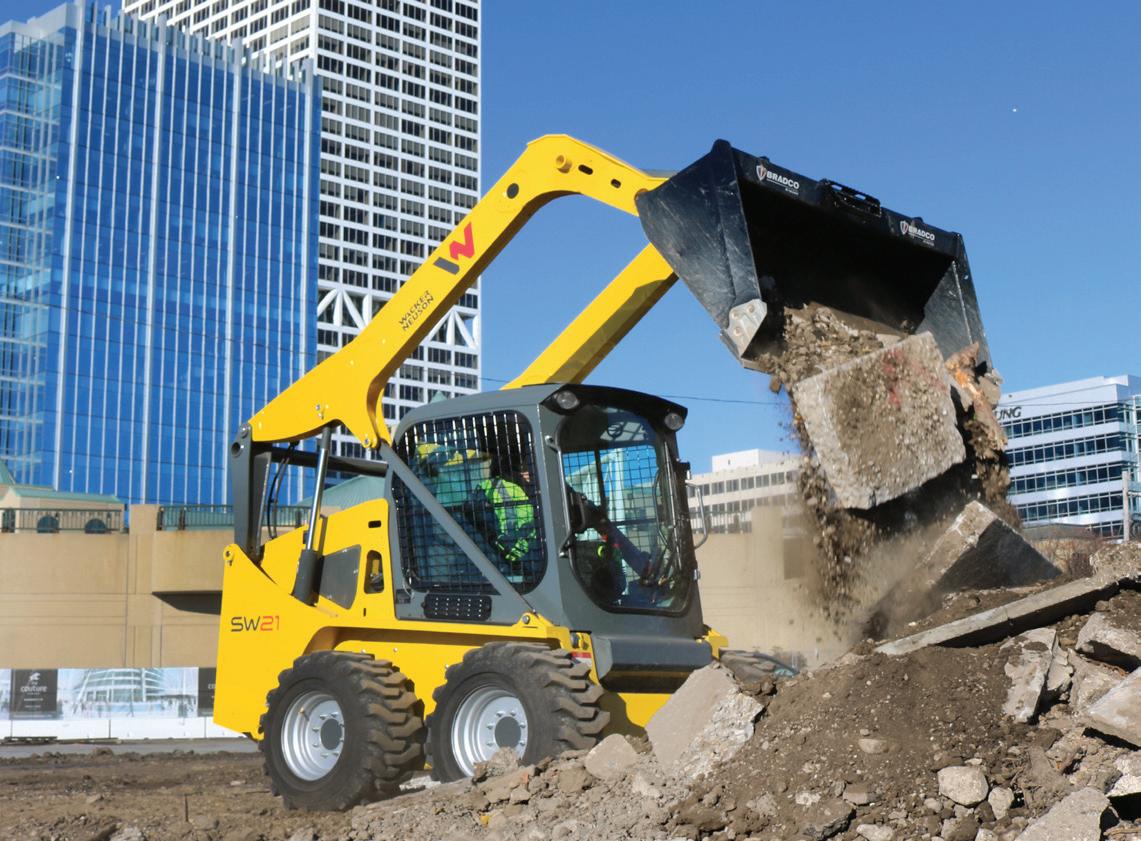


www.wackerneuson.com






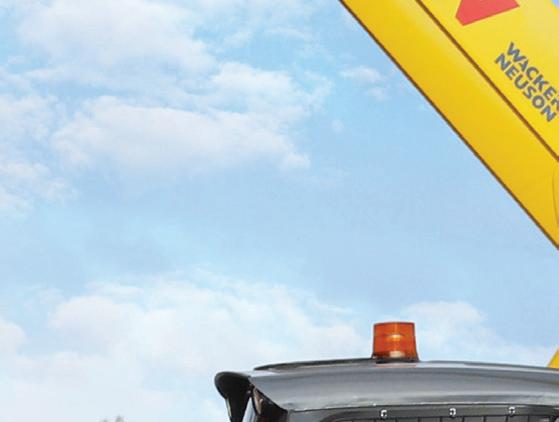







2023 Skid Steer Spec Guide
The skinny on dozens of new skid steers at your fingertips.



BREAKING GROUND
Tough Technology On the Road & Off
Hands-on experience with equipment and trucks improves my ability to understand jobsite conditions.
EQUIPMENT INTRODUCTIONS
Check Out the Latest Equipment
The latest machines from major manufacturers.
PROFIT MATTERS
Four Crucial Trends in Construction Machine Control Off-road equipment technology is allowing fewer operators with less skill to do more.
RUNNING THE BUSINESS
Decision Time
Using technology for your business improves the bottom line and decreases your time using pen and paper.
BRIDGING THE GAP
Diversifying Construction Labor Pools With Intention Being intentional about posting positions marketing to different talent pools is key to refreshing your old recruitment routine.
EARTHMOVING TRENDS
Evolving Tech of Brush & Land Clearing Equipment

Mulchers and mulcher attachments are evolving, offering new benefits for land clearing, including a cleaner finish.
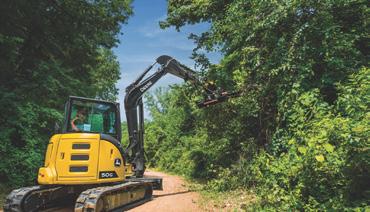
EARTHMOVING TRENDS
Use of Site Dumpers Increasing in North America

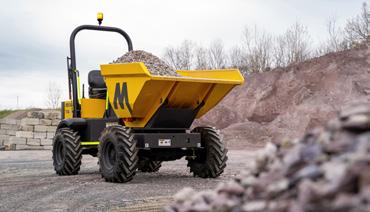
There are many factors that make site dumpers so popular overseas, such as advanced safety features.

EARTHMOVING TRENDS
Three Factors Driving the Trend for Full-Size Stand-on Skid Steers
A step up from a traditional compact skid steer, these machines have a smaller footprint.
FLEET MANAGEMENT
Tire Technology Isn’t Static
Digital solutions, new tread patterns and proper maintenance improve fleet uptime and efficiency.

FLEET MANAGEMENT
Navigating the Shift to Electric
With sustainability at the forefront, manufacturers are providing electric options for contractors.
FLEET MANAGEMENT
Demolition Manufacturers Draw Engineer Electric Models
The real challenge is optimizing performance, especially in heavy duty applications.
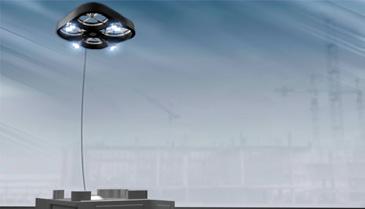
TECHNOLOGY
Lighting Sites in New Ways
Battery, solar and drone systems are changing how operators see the jobsite.
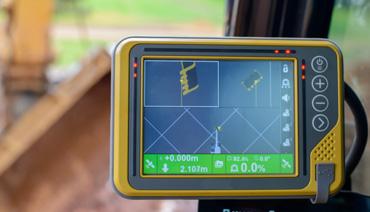
TECHNOLOGY
Why Managing Edge IT Is Critical For Construction Companies


IT asset management plays a role in the success of construction companies, as more assets are deployed in unmanned, remote sites.
TECHNOLOGY
The Road Less Traveled Can Offer Greater Screening Productivity Departing from traditional screening systems to advanced technologies improves productivity and profits.
TECHNOLOGY
ChatGPT: The Next Frontier of Construction Contracts
Whether you find generative AI exciting or scary (or maybe a bit of both), AI has already optimized construction contracts.
TECHNOLOGY
Advances in Machine Control

Advancements in machine control are bringing improved safety and efficiency to work truck operations.
EARTHMOVING TRENDS

Heavy equipment for earthmoving.
FLEET MANAGEMENT
The latest in tires and fleet management products.
TECHNOLOGY PRODUCTS
The latest construction technology.
VIDEO NETWORK https://eqtoday.co/k2p285
DIGGING DEEPER PODCAST https://eqtoday.co/s7sfkm
CONTENT https://eqtoday.co/9pd73s
lditoro@ACBusinessmedia.com
Last month, I talked about my first time driving a wheel loader with the Mecalac team. This month, I’ve driven another exciting vehicle. Ford hosted media professionals in June to drive and learn more about the new 2023 F-Series Super Duty pickup.
We didn’t just drive these flexible, powerful vehicles on the road, which was a pleasant, smooth experience. We drove them off-road, including through twist ditches and muddy tracks and up a rock hill (check out the QR code below for a video of a fellow driver on the course tackling this obstacle).
We also had the opportunity to drive a truck fully loaded through different road conditions, including up and down hills.
The 2023 Super Duty, according to presentations at the event, is more efficient and simplified. I jumped right in and drove just like my passenger car at home, so I agree with the idea of simplification.

Comfort is also a priority, including while driving offroad, which I’d never done before. Imagine my surprise to spray mud all over the truck and drive through branches and leaves to stay on the trail.


Even with this toughness, the interior includes modern amenities. Each truck features fleet management software, telematics and a 5G modem for connectivity.

In addition, the XL model includes an 8-inch display, while the Lariat and higher trim models have a 12-inch display. The interior also features four USB power ports and an available wireless charging pad and a center console slot that holds a tablet upright to make using it easier when parked.
More to come later about this truck, which can perform tasks on the jobsite and off-road.
This issue also features equipment that performs on the jobsite and to prep the jobsite. First, check out the Skid Steer Spec Guide on page 8 to see the latest technology in this category. For more on skid steers, see the latest trends on page 18.
Some other industry trends include diverse jobsite lighting options (see page 32) and site dumpers (page 16). Also, don’t miss the article about how ChatGPT can help you on page 38.
As always, let us know what you’d like us to cover and discuss in upcoming issues by emailing me at lditoro@acbusinessmedia.com. We always love hearing from you!

Watch the video: https://eqtoday.co/rockclimb.
EDITORIAL
Editor-in-Chief Lori Ditoro lditoro@acbusinessmedia.com
Managing Editor Gigi Wood gwood@acbusinessmedia.com
Senior Editor, Construction Technology, IRONPROS Charles Rathmann crathmann@acbusinessmedia.com
Senior Editor, Equipment & Workwear, IRONPROS Michael Cheng mcheng@acbusinessmedia.com

AUDIENCE
Audience Development Manager Angela Franks
PRODUCTION
Senior Production Manger Cindy Rusch crusch@acbusinessmedia.com

Art Director Kimberly Fleming kfleming@acbusinessmedia.com
ADVERTISING/SALES
Brand Director Sean Dunphy sdunphy@acbusinessmedia.com
Assoc. Brand Director Nikki Lawson nlawson@acbusinessmedia.com
Sales Representative Kris Flitcroft kflitcroft@acbusinessmedia.com
Sales Representative Tadashi Soma tsoma@acbusinessmedia.com
Sales Representative Kristin Pride kpride@acbusinessmedia.com
Sales Representative Megan Perleberg mperleberg@acbusinessmedia.com
Sales Representative Greg Schulz gschulz@acbusinessmedia.com
AC BUSINESS MEDIA
Chief Executive Officer Ron Spink
Chief Financial Officer JoAnn Breuchel
Chief Revenue Officer Amy Schwandt
Brand Director, Supply Chain & Green Industry Jason DeSarle
Brand Director, Construction Sean Dunphy
VP, Audience Development Ronda Hughes
VP, Operations & IT Nick Raether
Content Director Marina Mayer
Director, Online & Marketing Services Bethany Chambers
Content Marketing, Marketing Services Jess Lombardo
Director, Demand Generation & Education Jim Bagan
CIRCULATION & SUBSCRIPTIONS
PO Box 3605 Northbrook, IL 60065-3605, Phone: (877) 201-3915 Fax: (847)-291-4816 circ.EquipmentToday@omeda.com
LIST RENTAL
Sr. Account Manager Bart Piccirillo, Data Axle 402-836-2768 | bart.piccirillo@data-axle.com
REPRINTS & LICENSING

Assoc. Brand Director Nikki Lawson nlawson@acbusinessmedia.com
E @EquipmentToday
D @EquipmentToday
C @equipment-today-magazine-official
Q @equipmenttoday
To get the best performance available for Bobcat® compact track loaders, it’s important to look at where the rubber meets the road … and the soil, and the concrete, or anywhere that your tracks will take you. Bobcat rubber tracks are made using a blend of natural and synthetic rubbers to minimize wear, providing strength and durability for the most demanding conditions.
Bobcat tracks also bring the traction needed to pull out your loader’s full capabilities. Wider and thicker roller path areas maximize your traction and reduce vibration. They also distribute the machine’s weight over a larger surface area, naturally improving your ride.
An investment in genuine Bobcat quality can pay off in longer tread wear and fewer track replacements. When tested against numerous aftermarket track brands, Bobcat comes out on top in terms of durability, superior performance and longer track life.
Compared to tested aftermarket tracks, Bobcat tracks’ tread life is up to 30% greater.
Choosing the right set of tracks will ensure more comfort, better production and longer tread wear.
That’s why Bobcat offers a range of tracks for different applications, so you can choose the best track based on your hours of use and application.
Here are a couple of highlights:
Compared to tested aftermarket tracks, Bobcat tracks tread life is up to 30% greater.

Don’t settle for second best when it comes to your compact track loader. Invest in Bobcat tracks and get superior performance and durability with longer life doing tough jobs. You can purchase Bobcat tracks online at Shop.Bobcat.com/Rubber-Tracks or by contacting your local dealer.
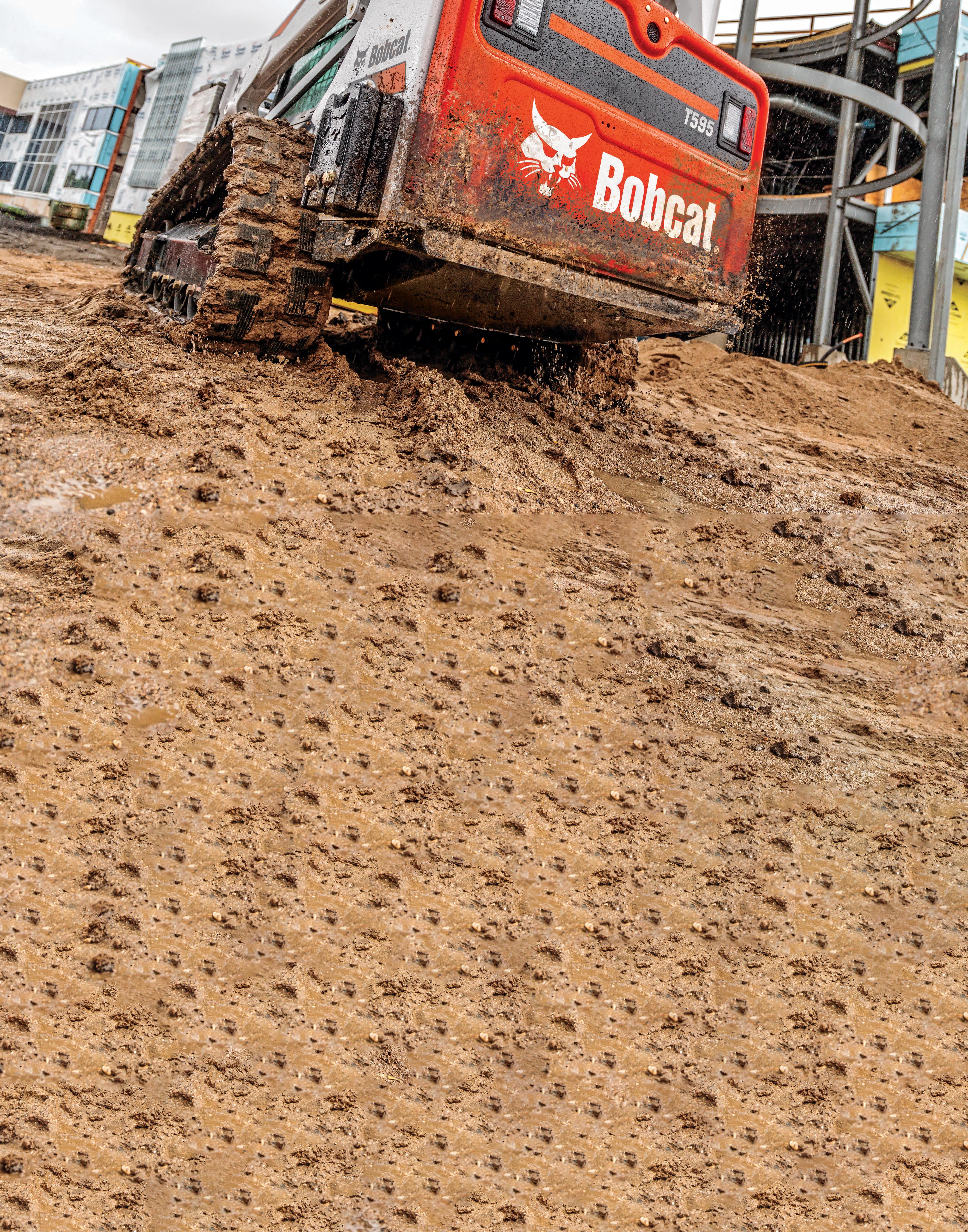
These pages feature some of the latest equipment available. For more information on these products, use the QR code shown.
Takeuchi expanded its TB300 Series excavator product line with the new TB350R short tail swing compact excavator, the first short tail swing model in the manufacturer’s 5-ton class. The TB350R has a rear swing overhang of just 2.95 in., helping minimize rear-swing impacts.

The TB350R weighs 10,980 lbs. in canopy configuration and 11,235 lbs. when equipped with a cab. It is powered by a Kubota V2607-CR-E5B diesel engine that is U.S.
EPA Tier 4 Final compliant and delivers 41.7 net hp (ISO 9249 and SAE1349) and more than 130.2 ft-lbs. of torque.
A four-pump hydraulic system delivers smooth, harmonized control of the work equipment. The TB350R provides a bucket breakout force of 10,431 lbs., a traction force of 12,320 lbs. and a maximum dig depth of 11 ft., 8.8 in.
Read More at https://eqtoday.co/kd71w57
Hitachi added the ZX190LC-7 excavator for construction projects to its portfolio of heavy-duty machines. This 43,652-lb. (19,800kg) excavator offers a 23-ft., 2-in. (7.07-m) maximum digging depth and 28,551-lb. (127-kN) bucket breakout force. The HIOS IV hydraulic system minimizes hydraulic loss while supporting performance. The HIOS IV hydraulic system features a responsive boom, arm and bucket with intuitive control. On the ZX190LC-7, the system produces a maximum flow rating of 100 gpm (380 lpm). Attachment, arm and swing priority can be adjusted on the monitor to match the attachment or the operator’s preference. A Yanmar engine puts out 132 hp (98.6 kW). The Yanmar power system features economy, power and high-power modes to match available power to the working conditions. An auto idle system with auto shutdown control prevents wasted fuel.


Read More at https://eqtoday.co/2qwkqf
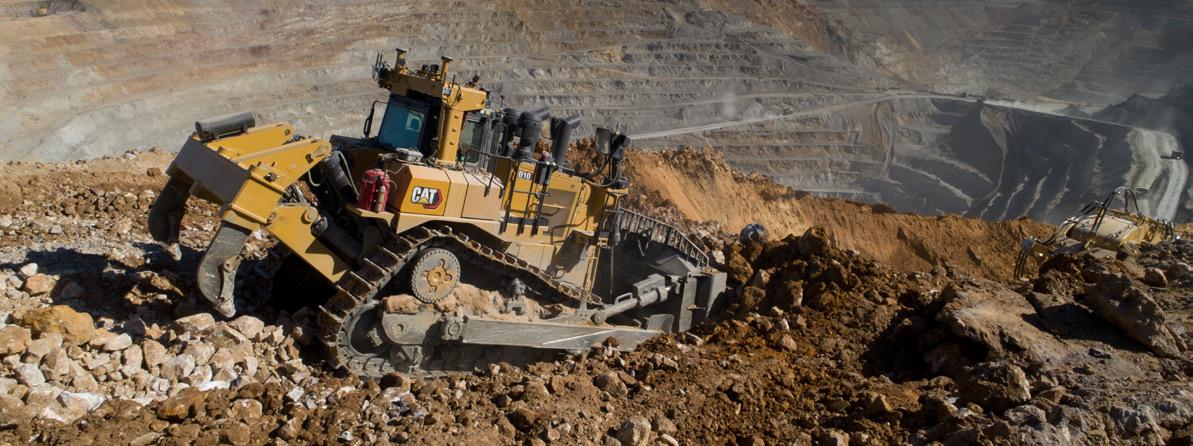
The new D10 is powered by the Cat C27 engine, which offers aftertreatment solutions to meet U.S. EPA Tier 4 Final/EU Stage V as well as Tier 2 equivalent emissions standards for meeting the needs of the global market. Maximizing material moved per liter of fuel, the C27 switches power settings based on travel direction to deliver power in reverse. The new D10 offers up to a 4% fuel consumption advantage over the D10T2 and up to 10% over the D10T. The dozer’s new torque converter design with stator clutch automatically frees up the stator when torque multiplication is not required. During high-load and retarding conditions, the stator clutch locks without the need for operator input.
Read More at https://eqtoday.co/43m660
The CX42D delivers a high level of feature standardization with excellent options to further improve performance. A standard two-way blade with float improves backfilling and grading operations, while an optional six-way blade seriously beefs up those capabilities. While the zero tailswing design provides excellent access to tight sites, additional counterweights can be added for further balance and confidence. Standard two-speed travel with automatic shift down improves performance when tracking/carrying up hill. Standard multifunction (1-way/2-way) hydraulics and standard 2nd auxiliary (2-way) circuit make these new D Series machines attachment beasts, while an optional 3rd auxiliary circuit delivers even more versatility. Each machine comes standard with a thumb bracket and can be ordered from the factory with an optional thumb.
Read More at https://eqtoday.co/p89jyw
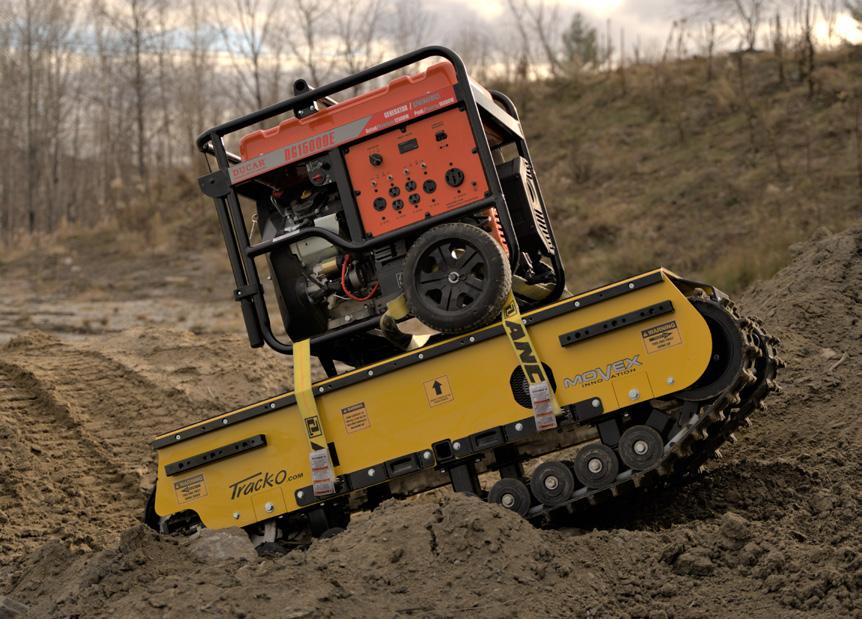
The Movex Track-O Cross-Country serves as an all-terrain truck for transporting equipment, materials and heavy items on rugged jobsites. This product is designed for outside work and makes it possible to reach hard-to-access places, such as mountains and backyards even in conditions that include snow, water, mud and sand. It has a clearance of nearly 9 in. (23 cm) that enables it to negotiate obstacles or bumps such as stones, tree stumps, etc. The all-terrain truck Track-O Cross-Country can climb 40-degree slopes. This model can be adapted to the customer’s needs by adding a crane attachment or other accessories. The runtime is nearly 2.5 hours and can be extended by adding another battery. With an operating voltage of 24 VDC, the battery recharge time is approximately eight and a half hours.
Read More at https://eqtoday.co/nvhenx
HEVI offers the GEL-5000 all-electric wheel loader for loading, transporting and material handling on construction sites. With its electric motor and battery system, the GEL-5000 offers performance, while minimizing emissions in outdoor environments. With a 5-ton load capacity, the GEL-5000 is for contractors, landscapers and other professionals who need a reliable and highperforming wheel loader. The work vehicle includes a 282-kWh battery, a base charger (220 V, with an optional 480-V upgrade) and a 3.9-cu.-yd. bucket. Capable of delivering 9 hours of operating time on a full charge, the GEL-5000 is compatible with a range of Electric Vehicle Supply Equipment (EVSE) brands, such as Blink Charging and Siemen’s eMobility.
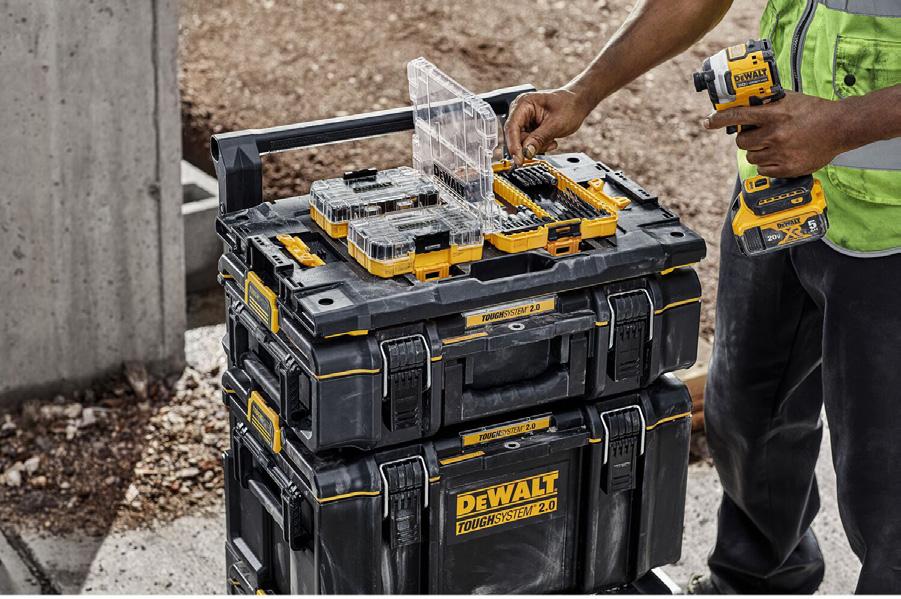
DEWALT expanded its TOUGHSYSTEM 2.0 storage portfolio with three new products: Adaptor, Deep Compact Toolbox and Three-Drawer Toolbox. The new TOUGHSYSTEM 2.0 Adaptor (DWST08017) allows users to build a versatile and customized storage solution through expanded compatibility. The TOUGHSYSTEM 2.0 Deep Compact Toolbox (DWST08035) is built for durability in tough working environments. The IP65 water resistant toolbox offers abundant storage with a volume capacity of up to 5.3 gallons or 20 liters and up to a 77-lb. load capacity. The TOUGHSYSTEM 2.0 Three-Drawer Toolbox (DWST08330) has three shallow drawers with a load capacity of up to 43.5 lbs./19.8 kg total or 14.5 lbs./6.6 kg per drawer to store and transport small tools and accessories.
Read More at https://eqtoday.co/xfkvzz
Read More at https://eqtoday.co/lth5oe
AUSA launched the D151AEG electric dumper, which can be paired with a mini-excavator. The D151AEG, which has a 3,300lb. and 1.18-cu.-yd. payload on its swing skip, allows operators to offload earth, rubble or other materials at an angle using a joystick. Because of its compact size, this machine is designed for work in tight spaces. The D151AEG dumper is equipped with a liion battery power unit. In the case of this dumper, it features a pack with a 9.3-kWh capacity, enough for at least one full day of work. Its 7.6-kW batteries and peaks of up to 17.3 kW are managed electronically to offer power and all-terrain capabilities.



Read More at https://eqtoday.co/slxcbp
To address the needs of customers looking for compact solutions on the jobsite, John Deere expanded its Performance Tiering offerings with the shift from L-Series to P-Tier for the 244, 324 and 344 Compact Wheel Loader models. The new P-Tier compact wheel loaders will carry over all L-Series capabilities and will introduce new features, including standard ride control in base models and optional factory-installed features, including an auto-reversing fan option. Additional optional features include attachment assist controls, which include integrated electrical (three-pin) controls for attachments and combined creep control and throttle lock. The upgraded combined creep control and throttle lock found within the attachment assist controls package allows customers to run their machines with higher rpms and lower ground speeds with overall fewer manual inputs when using attachments. Pause and resume functions can be used for reactivating the feature after a change in direction or switch to neutral.

Read More at https://eqtoday.co/52w2hg
Equipped with a powerful 250-hp CAT C7.1 Tier 4 Final engine, the Morooka MST110CR is emissions compliant and reliable. With an upgraded final drive, it can reach a top speed of 8.7 mph, an increase of 18% over the previous model. The Morooka MST110CR also features a rugged HARDOX steel dump bed, resistant to impacts and wear. The Morooka E-Hydro Control, or M-EHC, system, provides electronic monitoring of systems, while the single joystick control enables operators to maneuver the machine. This machine offers auto deceleration and a ROPS cabin. Side and rear cameras provide a clear view of the surrounding area.
Read More at https://eqtoday.co/cwnrx4



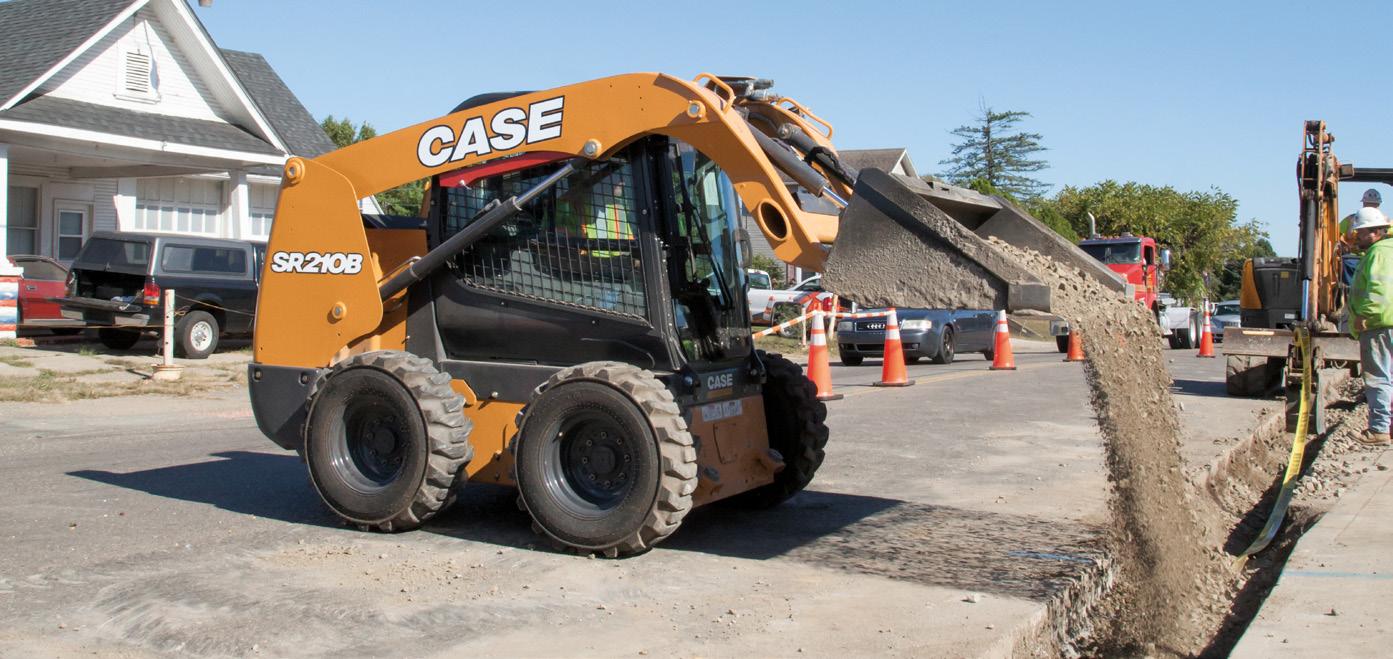
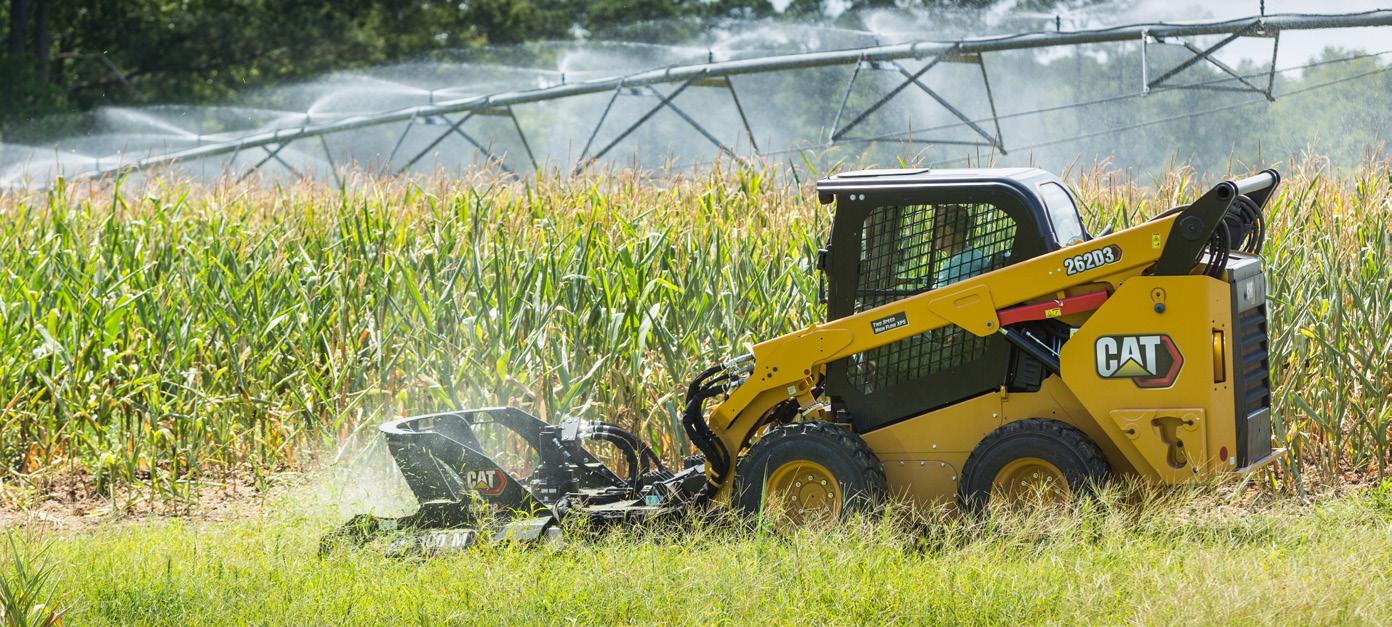


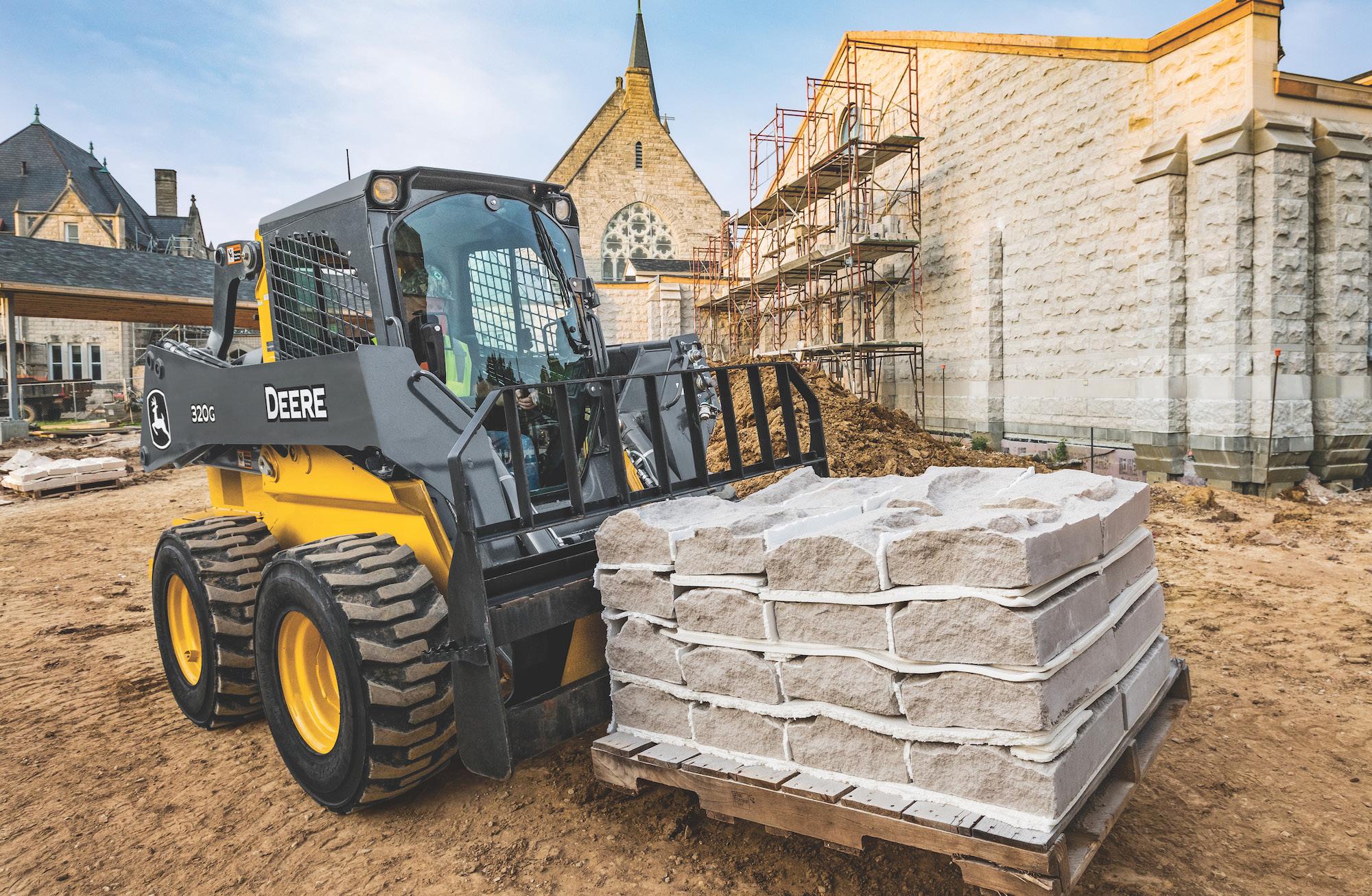

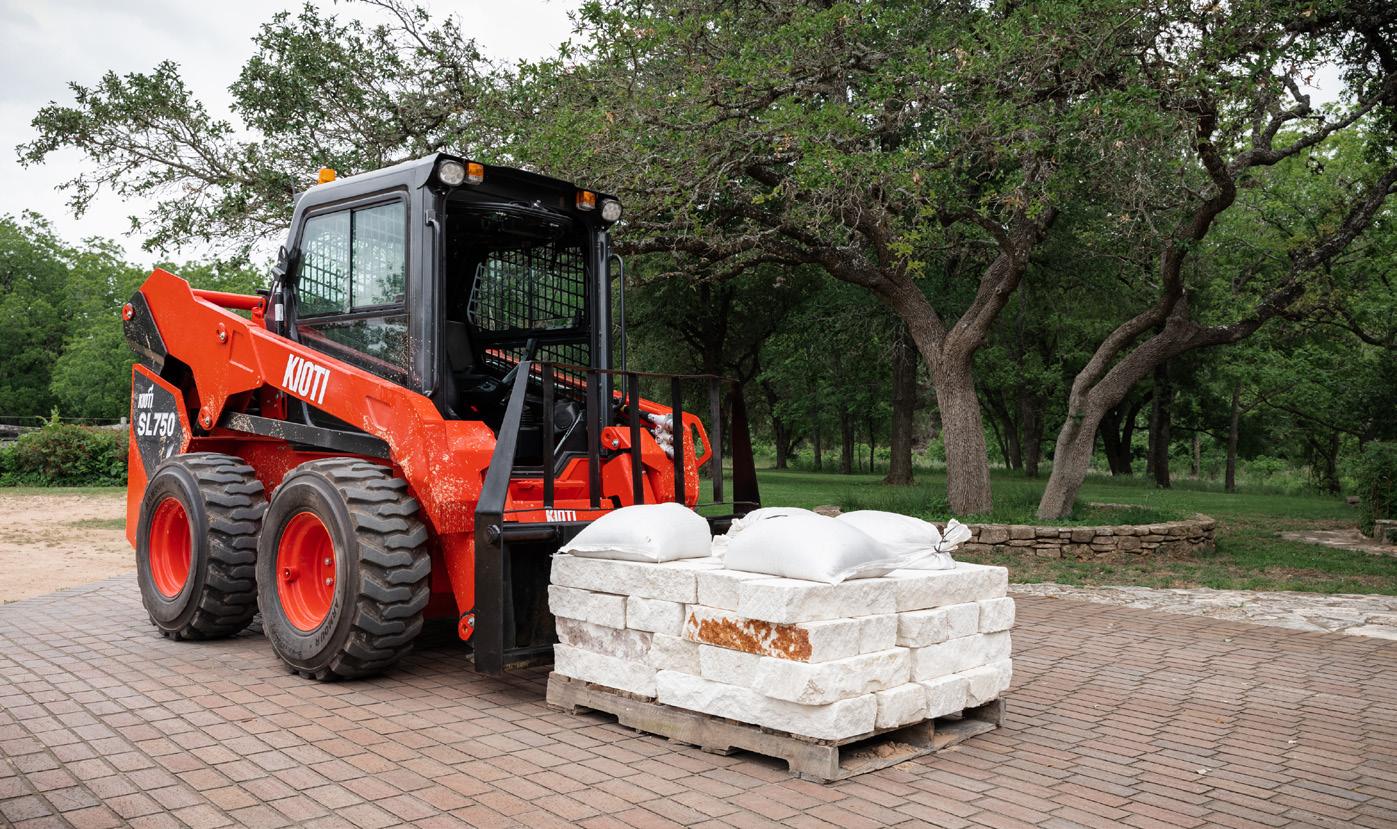










Mulchers are evolving, offering new benefits for land clearing, while mulcher attachments have become smaller, lighter and, consequently, more efficient, so they can be used on smaller, mid-frame machines.
As the construction industry continues to flourish, site preparation and land clearing work are steadily becoming more popular. In response, numerous manufacturers are offering a wider range of equipment that enables professionals and contractors to clear land and brush as they prepare for new construction opportunities.
For example, Caterpillar has the Cat BR320 brush cutter. It can remove thick brush and saplings, allowing operators improved access to properties, which is the “first step in a land clearing job,” said Brock Bahr, senior sales support specialist, Caterpillar. For a clear path and to have as clean of a finish as possible, Bahr advises operators to pair the BR320, which can cut a tree of up to 3 inches in diameter, with a D3 Series skid steer or compact track loader (CTL).
After clearing smaller, thick brush, operators can focus on more significant obstacles. Bahr believes they should use an industrial brush cutter or mulchers, whichever option is the most ideal for them, according to their particular property’s terrain and accessibility.
“The Cat BRX318 industrial brush cutter can do everything the BR series can and more, as it was designed for land management, small trees and dense vegetation,” Bahr stressed. “With its four blades, reinforced push bar and open-face design, the BRX can get close to large debris, such as trees that are up to 8 inches in diameter, as it cuts them close to the ground.”
He added, “It pairs well with skid steers, CTLs and compact wheel loaders, too. Although the BR series leaves a much cleaner finish, if operators want to remove everything and the final finish isn’t an issue, they should consider using the Cat BRX318.”
To remove large trees, operators can also use a mulcher. Caterpillar currently provides nine different
models, along with two different drum styles. The manufacturer’s most common drum style is its standard or open drum mulcher, with either carbide teeth (such as the HM316 and the HM418) or reversible chisel teeth (like the HM112 and the HM215).
According to Bahr, the mulchers’ standard or open drums don’t limit tooth engagement, resulting in a significant bite and, in turn, higher productivity. If operators are working on sites that have rough and rocky terrain, Bahr thinks carbide teeth are the most ideal option. After all, they’re highly durable and more forgiving than chisel teeth. And they require less maintenance than chisel teeth because they’re less prone to damage.
In addition, the manufacturer provides depth control or bite limiter drums on its HM316, HM416 and HM418 offerings.
Each of these drums have chisel teeth and depth control rings that decrease bite size and offer operators a helical tooth pattern. Consequently, the HM316, HM416 and HM418 can cut faster, burn less fuel and provide operators a cleaner finish when compared to other mulchers on the market, Bahr said.
“Each Cat mulcher comes standard with a heavy-duty, adjustable push bar, as well, which directs 8-inch trees away from operators as they cut,” Bahr said. “Furthermore, every Cat mulcher has adjustable, replaceable skid shoes, a two-speed hydraulic motor and a color-coded pressure gauge, which offers operators feedback, leading to higher productivity.”
Prior to purchasing a Caterpillar industrial brush cutter or mulcher, operators should keep in mind how much space they have to operate. The machines require some space for maneuverability to be as close to the tree bases as possible.

If operators don’t have enough space, they can consider buying a mini excavator. A mini excavator can be parked in one location since it
can reach out to cut several trees and brush without having to be moved.
Once operators have removed trees, whether they choose to use an industrial brush cutter, a mulcher or a mini excavator, they must eliminate stumps, too. To do so, operators can attach Caterpillar’s 46-inch stump bucket, which can be used for small stumps and roots. Offering a long, narrow design with serrated edges, the stump bucket allows operators to dig closely around and underneath stumps’ root balls.
Operators can consider using Caterpillar’s SG36 stump grinder, as well. Featuring a 22-inch cutting wheel with 32 carbide teeth, the SG36 is known for its rapid stump removal.
“To ensure they quickly and efficiently remove whichever stumps they need to, operators can extend the SG36’s head up to 11 inches and swing it 60 inches to the right and left, if necessary,” Bahr added. “Not to mention, while grinding stumps (up to 20.5 inches below the ground),
operators will never have to leave the comfort of their cabs, either.”
In the past, site preparation was completed by pushing vegetation over with dozers and excavators. Unfortunately, this process led to a considerable mess of brush and branches, which would generally need to be burned. Brush cutters and mulchers allow for a cleaner option that allows contractors to remove vegetation in a mechanized fashion instead.
In addition to offering a cleaner finish, these mechanized options are
evolving, said Matt Nelson, director of development at Diamond Mowers. For instance, mulching attachments are becoming more efficient regarding the ways in which they cut and mulch because they’re leveraging enhancements in components such as hydraulic motors and cutting tooth technology.
Moreover, mulcher attachments, which were previously suitable for large-frame and high-flow skid steers and CTLs, have become smaller, lighter and, consequently, more efficient because they can be used on smaller, mid-frame machines. Therefore, contractors no longer have to purchase machines dedicated only to land clearing. Instead, they can use the loader they already have and choose an attachment that fits, resulting in cost savings.
In preparation for the future of mulching, Diamond Movers recently announced its Belt Drive Disc Mulcher, which features a patented driveline that leverages a two-speed hydraulic motor that runs through a gear-reduction belt system. Due to its design, it increases operators’ production by 20% to 40%, in comparison to traditional disc mulcher designs. And, of equal importance, it also diminishes hydraulic oil temperatures.
“We believe the mulcher will positively impact the contractor market, as its ability to enhance productivity will ensure [that] it’s a clear choice for those who are paid according to output,” Nelson said.
In the meantime, Diamond Mowers has released the Drum Mulcher OD (open drum) Pro X as well, which provides a hybrid design that integrates the features of depth control and open drum mulchers into one attachment. Created to enable heavy ground engagement, the product has an infeed system that leads to a smaller, more uniform and aesthetically-pleasing end product once operators have finished their first pass.
“It has not only allowed contractors and landowners to realize an improved finished product, but it has also reduced their operating costs and boosted their profits,” Nelson emphasized.
With regard to brush cutters, Diamond Mowers presently has two options, the Brush Cutter Pro and the Brush Cutter Pro X. Each of these attachments are compatible with skid steer carriers or CTLs, as they feature hydraulic motors that are properly sized for enhanced blade performance and safe handling at every flow level.
Offering high durability and multifaceted cutting capabilities, the Brush Cutter Pro can be used for a wide array of applications and carriers. After all, it has two steel blades that can maintain a 72-inch cutting width, while cutting through branches, brush, grass and small trees that are up to 5 inches wide. Featuring a lower push bar, the Brush Cutter Pro can reach under fences, too.
Meanwhile, the powerful and versatile Brush Cutter Pro X provides three cutting widths: 60 inches, 72 inches and 84 inches. Utilizing three steel blades, it also has a Tr-Hex cutting disc that can slice through different materials, including those that have diameters of up to 10 inches.
Once operators have used the Belt Drive Disc Mulcher, the Drum Mulcher OD Pro X, the Brush Cutter Pro or the Brush Cutter Pro X, Nelson advises them to use one of Diamond Mowers’ two stump grinders, the Reflex Stump Grinder or the Miller Stump Grinder. Particularly ideal for land clearing and rural grinding applications, the Reflex Stump Grinder uses a skid steer’s lift arm to position its wheel in a stump prior to driving it through the wood with its wheels or tracks.
“Easy to operate, the Reflex Stump Grinder is equipped with a patented cushioning device that protects the wheel from too much pressure, alleviating overload by flexing and keeping the wheel out of harm’s way,” Nelson said. “Grinding wheels are available in 24-inch or 26-inch cutting widths and are paired with an appropriately sized motor to match the machine’s hydraulic flow.”
Meanwhile, the Miller Stump Grinder can cut stumps up to 36 inches in diameter without moving the carrier. Using a 26-inch, six-way grinding wheel that features swing, lift and telescoping functions, the stump grinder enables operators to process a stump with the loader in one position.
“Therefore, the risk of soil and turf damage declines,” Nelson added. “With this in mind, it is especially
ideal for settings in which aesthetics are important.”
Although construction projects are diverse regarding their types and locations, contractors all strive for one common goal—a clean, suitable jobsite.
To achieve this in the most effective way, they should utilize mulching equipment, particularly drum mulcher attachments, according to Ryan Bricker, product manager at Fecon. Attachments, after all, are not only efficient, but convenient, too, as they can be effortlessly paired with equipment found on most jobsites.
To provide operators efficient and convenient mulching equipment, Fecon has several attachments they can choose from, including models that have been optimized for standardflow and high-flow skid steers and excavators.

One attachment that has recently been added to the manufacturer’s mulcher attachment lineup is the BULL HOG RK6015 skid steer drum mulcher. A standard flow mulcher attachment developed especially for landscape construction and lighter vegetation management, it can mulch brush and trees that are up to 5 inches in diameter.
“It’s ideal for right-of-way maintenance for road construction, as well as clearing of smaller lots for building projects,” Bricker noted. “In addition, it’s optimized for 50-horsepower (hp) to 75-hp skid steers, which can be found on virtually any construction jobsite.”
Furthermore, contractors can use the manufacturer’s FMX28 mulcher, which has been created for 3.5-ton to 8-ton standard-flow excavator models. It can clear trees and brush alongside creeks, ravines, riverbanks, roads and other areas that are difficult to reach.
Also a draw for rental centers, in particular, the mulcher offers contractors an attachment option that’s effortless to rent, use for a project and return once the project has been completed.
“Because of excavators’ unique operations, the mulcher opens the door to the usage of compact excavators in mulching applications, specifically for selective or precision mulching,” Bricker explained. “It’s especially suitable for clearing small pads for tower construction or removing invasive species.”
Finally, contractors can use the BLACKHAWK BK6218, a mulcher that’s been designed to quickly process the fibrous, stringy vegetation that’s typically found in the Southeast.
“Utilizing a DCR rotor, a shear bar, a wear liner and a body geometry that enables it to tackle trees that have fallen or are standing, the mulcher

To ensure land and brush clearing is more effortless for operators, John Deere Construction and Forestry offers specialized attachments like the ME36 mulchers.John Deere John Deere
Because of its four blades, reinforced push bar and open-face design, Caterpillar’s Cat BRX318 can get close to large debris, such as trees that are up to 8 inches in diameter, and it cuts them close to the ground.
can clear any jobsite,” Bricker added. “And, due to its rear throat, it can process debris during back dragging, without ever leaving any unprocessed materials behind.”
Without question, contractors have a wide array of options to clear land at jobsites. Sometimes the job calls for equipment with specific functions.
Other times, equipment is chosen based on the types of brush and land that operators need to clear. With this in mind, John Deere Construction & Forestry has a variety of equipment for operators to choose from.
“We provide drum-style mulchers that can process material into smaller pieces, along with disc-style cutters that cut, knock down and process the larger pieces,” said Doug Laufenberg, solutions marketing manager, attachments at Deere.
“If timeliness is critical, disc-style cutters may be the more suitable option, as they’ll likely cover more ground faster, since they aren’t processing material into smaller pieces.”
Deere also offers grapples and root rakes with which operators can knock down the growth and then gather material with a grapple or a rake to dispose of in another way, he added.
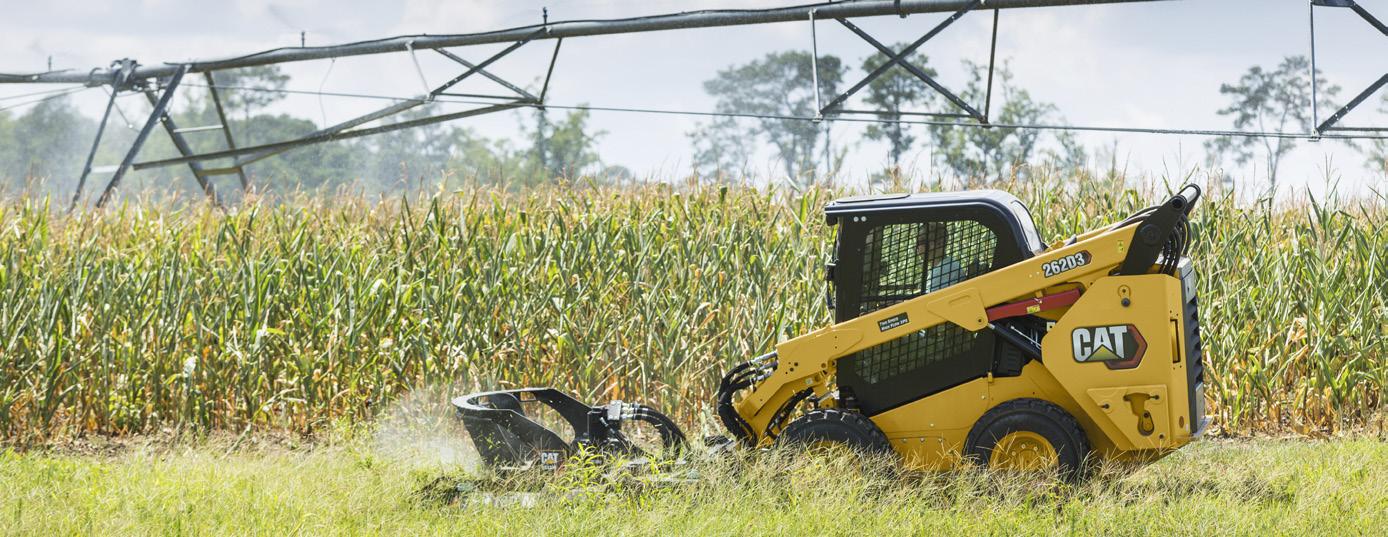
Recently, Deere added drum and disc mulchers to its compact excavator lineup. Furthermore, the manufacturer has introduced a depth control rotor on its skid/CTL mulcher.
As a result of the rotor, operators can minimize “the bite that the drum (of each drum mulcher) can take on trees,” according to Laufenberg. It also allows operators to work with thinner, twiggy wood more efficiently, whenever they need to cut and process brush and trees.
To ensure land and brush clearing is more effortless for operators, the manufacturer offers specialized attachments like the ME36 and ME50 mulchers, which are equipped with knife-style cutting teeth on a split ring motor.
“The mulchers’ spiral, double helix tool patterns, along with their tool shapes, enable operators to quickly and efficiently cut mulch that’s up to 5 inches in diameter,” Laufenberg said.
Deere provides brush cutters like the RE40 and the RE50 that offer more versatility for excavators. Especially ideal for embankment and ditch management, over-fence brush management and rail right-of-way maintenance, the brush cutters can be used for other areas that are difficult to reach, as well.
“Each of these attachment offerings allow operators to tackle land clearing and brush cutting tasks with the equipment they likely already own,” Laufenberg stressed.
“However, since they’re made specifically for brush cutting and land clearing, operators can achieve these tasks more efficiently than they previously did.”
As evidenced by the wide assortment of product offerings on the market, from brush cutters, to mulchers and stump grinders, land and brush clearance is a complicated undertaking. Clearing jobsites is only becoming more complicated as the construction industry continues to evolve.
The bottom line? Operators’ equipment use must evolve, as well, to ensure their land and brush clearance processes are as effective and straightforward as possible.
“As roads and utility infrastructures expand and alternative energy sources grow, the need for brush and land clearing will only continue to grow, too,” Fecon’s Bricker said. “Evolution will be the name of the game, as manufacturers continue to respond to this growth through continuous changes.
“[Because of] these evolutions in products and the demand for them, the future is certainly bright for brush and land clearing equipment manufacturers — and each of the professionals and contractors that utilize their offerings.”
Read more at: https://eqtoday.co/mulcher
To clear brush and land that’s difficult to remove, operators can use specialized attachments and tools.

Whenever Fecon launches a new product, the manufacturer is inspired by direct feedback and requests from customers. For example, after hearing customers in the Southeast express how difficult stringy, fibrous wood is to remove, the manufacturer developed its BLACKHAWK mulcher attachment
Because of its durable, heavy-duty design, the attachment can process and mulch this type of wood, ultimately resulting in a clean jobsite that’s fully prepared for future construction work.
Meanwhile, as a result of customers’ demands, it also developed its STUMPEX attachment, a safer alternative to traditional wheeled stump grinders.
“Operating with a low rpm (19 rpm to 41 rpm), as well as high torque (up to 33,000 foot-pounds), the attachment processes stumps—both above and below ground—with easy cleanup and no flying debris,” stressed Ryan Bricker, product manager at Fecon.
Aside from these two attachments, operators, whether they’re professionals or contractors, can use disc or drum mulchers, too, as they strive to clear brush and land that’s challenging to remove. While doing so, Matt Nelson, director of development at Diamond Mowers, advises them to install whichever teeth are the most suitable for their particular jobsites.
Carbide hammer-style teeth: Because of its durability, this type of teeth can be used in areas that are difficult to clear. However, they often bludgeon wood apart rather than cutting or slicing it, leading to a decline in productivity, an issue operators must bear in mind.
Steel teeth: Very sharp because they can be sharpened throughout their lifespans, steel teeth can effortlessly cut and slice through wood. Yet, they can also become dull rather easily, particularly whenever they hit rocks or contact with the ground.
A combination of both: Since Diamond Mowers’ cutting tools weigh the same, operators can mix and match teeth on their drums without impacting balance, according to Nelson.
“As operators encounter brush and land that’s difficult to clear, they’ll regularly install sharp steel teeth towards the middle of each of their drums, where larger materials are naturally processed, and carbide teeth towards the outside of their drums,” Nelson said. “This combination will enhance productivity and minimize operating costs, regardless of how challenging a jobsite is to clear.”



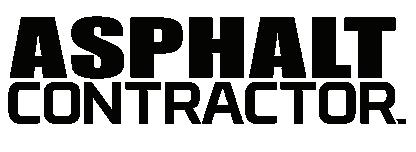



You’re less likely to see a site dumper in North America than in the U.K., where you may see an entire fleet on a jobsite. However, contractors looking for compact equipment solutions that offer more for their investment are starting to take notice of the factors that make the equipment popular overseas.
With advanced safety features and a compact footprint, site dumpers offer outstanding efficiency and safety on all jobsites—especially those where space is at a premium.

While contractors in Europe that are accustomed to compact jobsites have long appreciated the benefits of the site dumper in industries ranging from construction to agriculture, North America’s wide-open spaces invited and allowed larger equipment. Now, as urban sprawl continues and jobsites become smaller with heightened safety concerns, contractors across multiple industries are reconsidering the site dumper.
Site dumpers first gained acceptance in North America in the
concrete market. With numerous jobs requiring the delivery of concrete in tight areas that won’t accommodate a mixer truck or pump truck, site dumpers paired with an optional concrete chute accessory offer a viable solution.

The chute provides the added benefit of precisely dumping the concrete where it’s needed without splashing, effectively minimizing any cleanup.
The popularity of the site dumper is growing beyond the concrete industry into landscaping applications. With the ability to move much more material than a skid steer without tearing up turf, the site dumpers offer an ideal solution for not only hardscaping applications but also mulching and maintenance.
Along with landscaping, golf course developers purchase site dumpers to aid in the construction of new golf courses and find them a versatile tool for not only construction but also overall maintenance.
Cemeteries are perhaps one of the most often overlooked areas of growth for site dumpers. While few people like to spend much time reflecting
on cemetery management, those in charge of managing large cemeteries recognize the challenges of tight spaces, sensitive turf and even more delicate emotions. With so much on the line, it’s important to take extra precautions to be as careful, efficient and meticulous as possible. Many cemeteries find that by using a site dumper, they can quickly maneuver an excavator to dig a grave and load the soil directly into the site dumper, leaving no mess or tarps for the family to navigate. Then as soon as the burial is complete, the site dumper backs up and easily and quickly unloads all the material directly into the grave quickly and cleanly, finishing the burial. High flotation, low-impact turf tires provide additional benefits in all
As the array of site dumper benefits — including capacity, efficiency, safety and reduced diesel maintenance — become more apparent in North America, the growth of the site dumper market will undoubtedly increase.
these applications by limiting ground disruption.
But as jobsites continue to get tighter, construction challenges are driving up demand in general construction applications.
The enhanced efficiency the machines offer over traditional equipment solutions is perhaps at the heart of expanding interest in site dumpers in North America. Some manufacturers offer 3-ton site dumper models with capacities of 1.3 cubic yards for liquid material such as concrete, 1.7 cubic yards for struck material such as aggregate and 2.5 cubic yards for heaped material like mulch. Though skid steers were once the standard on any jobsite for moving a variety of materials, contractors are finding that replacing a skid with a skip (site dumper) and mini excavator duo often results in three to four times the material handling capacity. In addition, site dumpers increase efficiency because material can be loaded directly into the skip—or bucket—and left until maneuvered wherever needed, and dumped, instead of multiple material moves with a skid steer.
A more compact design and tighter operating footprint further enhances efficiency. The forward and swivel tipping mechanisms of site dumpers allow contractors to maintain a small jobsite footprint and improve safety.

Unlike skid steers, most site dumpers swivel and tip material out of the bucket without the need to reposition the entire machine. This allows operation in tighter spaces and minimizes additional maneuvering around an already tight jobsite.
To realize the benefits of the site dumper, it is paramount that contractors not just choose any brand or model, but a high-quality one from a trusted manufacturer.
Many features, though subtle to the eye, greatly affect safety, ease of operation and performance.

As sites get smaller and pressures increase to get more done, a keen focus on safety protects not only the operator but the entire jobsite and the company as a whole. Site dumpers designed with precise attention to detail, ensuring perfectly symmetrical wheels equal distance from the center articulation post of the machine, maximize safety and stability even while driving through heavily rutted areas in mud or other unstable terrain. This reduces the risk of tipping and provides a smooth ride, as the back wheels follow the same path as the front at all times.
With current skilled labor shortages, ease of use and intuitive controls present another key
consideration. Contractors gravitate toward models with controls that are easy to learn and use, benefiting safety, and allowing for a lower barrier to entry for operators at any experience level.
Finally, some manufacturers produce site dumpers with engines rated under 75 horsepower. This helps
avoid diesel exhaust fluid (DEF) and diesel particulate filter (DPF) related maintenance.
As the array of site dumper benefits—including capacity, efficiency, safety and reduced diesel maintenance—become more apparent in North America, the growth of the
site
With a load capacity from 2,200 to 22,000 lb and 0.74 to 5.1 cu yd skip capacity, the AUSA dumper collection will become your most valuable piece of equipment for your construction jobs. Designed to increase your profitability by being able to remove dirt faster than other equipment options, especially when combined with a mini excavator. Safety is also an increased highlight with visibility provided by the operator’s position located on top of the machine.
Visit www.ausa.com for more information
In today’s competitive construction industry, contractors are always looking for ways to make their work more efficient. New technologies and tools are constantly being introduced to increase productivity and safety on the jobsite. One tool that has become increasingly popular is the stand-on skid steer. These machines—which are a step up from a traditional compact skid steer but have a smaller footprint than other compact track loaders— offer several benefits that make them an attractive option.
In an industry where time is money, here are a few of the key reasons contractors are reaching for full-size stand-on skid steers.

If you’re having trouble finding crew members for your jobs, you’re not alone. According to the Deloitte 2022 Engineering and Construction Industry Outlook report, more than half of construction executives indicated that they are facing a severe labor and talent shortage on the jobsite. And these shortages are expected to continue.
While the industry works to find a solution, an easy and immediate step to compensate for a lack of workers is to maximize equipment. Contractors are looking for full-size, stand-on skid steers to fill in the gaps for lack of skilled labor. Increased horsepower on full-size stand-on skid steers means they have the ability to connect with larger attachments, in return being able to lift and move larger loads in fewer trips. This added power can fill the workforce gaps by lifting loads that would otherwise require three or four workers.
Additionally, storing and
transporting equipment can be a daily, yet headache-inducing task for contractors. To help eliminate the downtime associated with this task, it is crucial that you bring machinery onto the jobsite that is designed to be quickly stored at the end of the workday and easily transported from one project to the next. Stand-on skid steers are compact enough to fit on a trailer, yet large enough to make a difference in filling the gap for laborers.
In addition to added power and workforce support, contractors are reaching for full-size stand-on skid steers for their versatility. Rather than hauling multiple smaller, specialized machines to a jobsite, a larger standon skid steer can be outfitted to complete a wide variety of tasks. Fullsize, stand-on skid steers have the capability to be outfitted with power attachments like a microtrencher for fiber installation projects. A fullsize, stand-on skid steer can go from trenching for a utility installation to hauling gravel in a matter of minutes.
In fact, the versatility has made the tree care industry a major driver larger stand-on skid steer trend. Being able to move bigger logs means tree care professionals are spending less time making cuts before hauling away. Attachments like tree grapples and bucket grapples are being used to help improve efficiency in treecare jobs like debris removal. The compact size—compared to cabbed machines of the same operating capacity—also make it ideal for tree care professionals who need to seamlessly maneuver through yards and residential areas.
With smaller crews and high
demand, many contractors are taking on two or three different jobs in a day, so having a machine in the fleet with more power and versatility to stay efficient and cost-effective is key.
With the wide variety of attachments, a stand-on skid steer can be rented year-round for tasks like digging, hauling, grading and snow removal. This versatility means that the machine can be rented to a wide range of customers with different needs, making it a profitable addition to any rental fleet.
Compared to their cabbed counterparts, stand-on skid steers are a simpler, less intimidating option for inexperienced renters working on residential projects. The compact design of a stand-on skid steer allows it to fit navigate around obstacles, making it perfect for use in backyards or other confined jobsites.

Stand-on skid steers are designed to be easy to use, even for novice operators. The simple controls and intuitive design make it easy to get
started with the machine, and their reliability gives renters reassurance they’ll be able to complete projects with minimal maintenance. With a stand-on platform, operators receive a 360-degree view. This increase in jobsite visibility and comfort helps operators see what is happening around the machine, boosting jobsite safety.
With so many options on the market, there’s a reason contractors and renters are driving the trend for full-size stand-on skid steers. The powerful, versatile machines are a valuable asset to any rental lot or contractor’s fleet. They’re powerful enough to fill the gap where the workforce is short, yet simple enough for renters to hop on safely and get to work in their backyards. The range of attachments and easy-to-operate design makes full-size, stand-on skid steers a great option for those looking to get the best bang for their buck on the jobsite.
Read more at: https://eqtoday.co/c16gqw

The Canycom CMX1402 Ride-on Brush Cutter features four-wheel drive and large tires for added traction on slopes and wet ground.
• Hydrostatic drive system for smooth and seamless operation
• Shaft-driven cutter deck requires no belts or pulleys
• Adjustable cutter deck for trimming from 0 in. to 6 in.
• 389-cc Honda gas engine with a rated output of 14 hp
Grapple LIne
Ignite Attachment’s grapple lineup offers powerful, versatile tools that allow equipment operators to pick up and move heavy objects, such as logs, rocks, roots and debris, without sacrificing heavyduty performance capability. The Ignite grapple attachment is designed to fit a selection of machines and can be used in construction, demolition or landscaping projects. You will be able to find the root, rock and bucket grapples in 82-in., 74-in., 68-in. and 62-in. models. Ignite Attachment’s grapple line is capable of picking up and moving objects of various shapes and sizes. Its powerful jaws can grip objects securely, preventing slips or falls during transport.
The Compact Stumpex is a slow-speed, high-torque, auger-style stump grinder designed specifically for compact utility loaders.

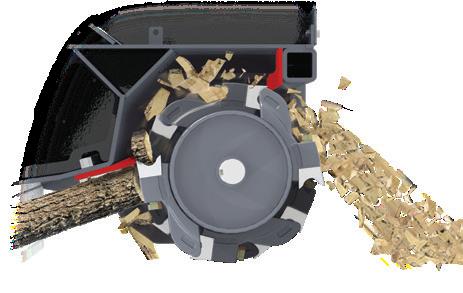

• Slow auger speed ensures a safer work environment with no flying debris and faster cleanup
• High torque eradicates stumps of any species from 4 in. to 11 in. in diameter in a single plunge
• Powerful, robust drive generates up to 4,000 lbs. of torque
• Features hardened auger cone that ensure positive draw into stump and stepped blades made of 1/2-in.-thick durable AR500 material
• Suited for compact utility loaders with 10 gpm to 20 gpm of hydraulic flow and 2,000 psi to 3,000 psi
The heavy-duty Battle Ax horizontal drum mulcher is offered in 61-in. and 71-in. cutting widths for skid steers with 50 hydralic hp to 120 hydraulic hp.
• 17-in.-diameter rotor features built-in depth gauges to prevent attachment from engaging too much material at one time
Two-stage cutting chamber allows material to be cut twice by the rotor and helps produce smaller particle sizes
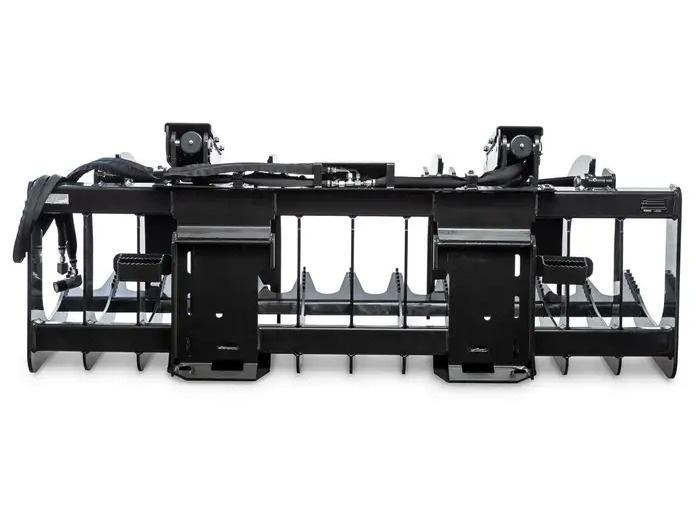

• Primary shear bar adjustable for customizing particle size
• Adjustable skid shoes (0.5 in. to 1.5 in.) enable below-grade mulching
• Fixed-displacement gear or variabledisplacement piston motor

The M60-S and M60-C forestry mulchers have a 60-in. cut width and are powered by a 160-cc variable piston hydraulic motor controlled by E-TECH Smartdrive.
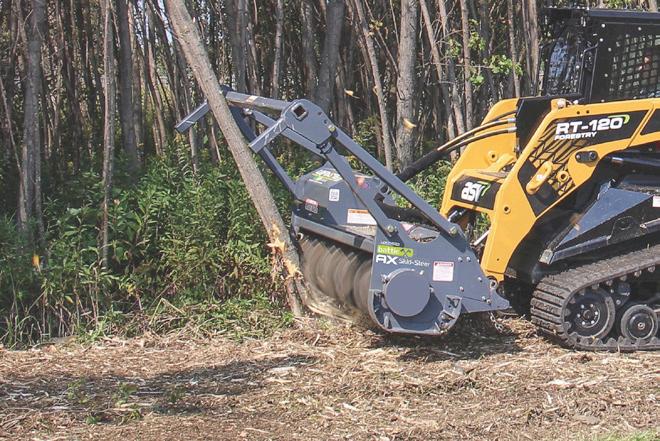
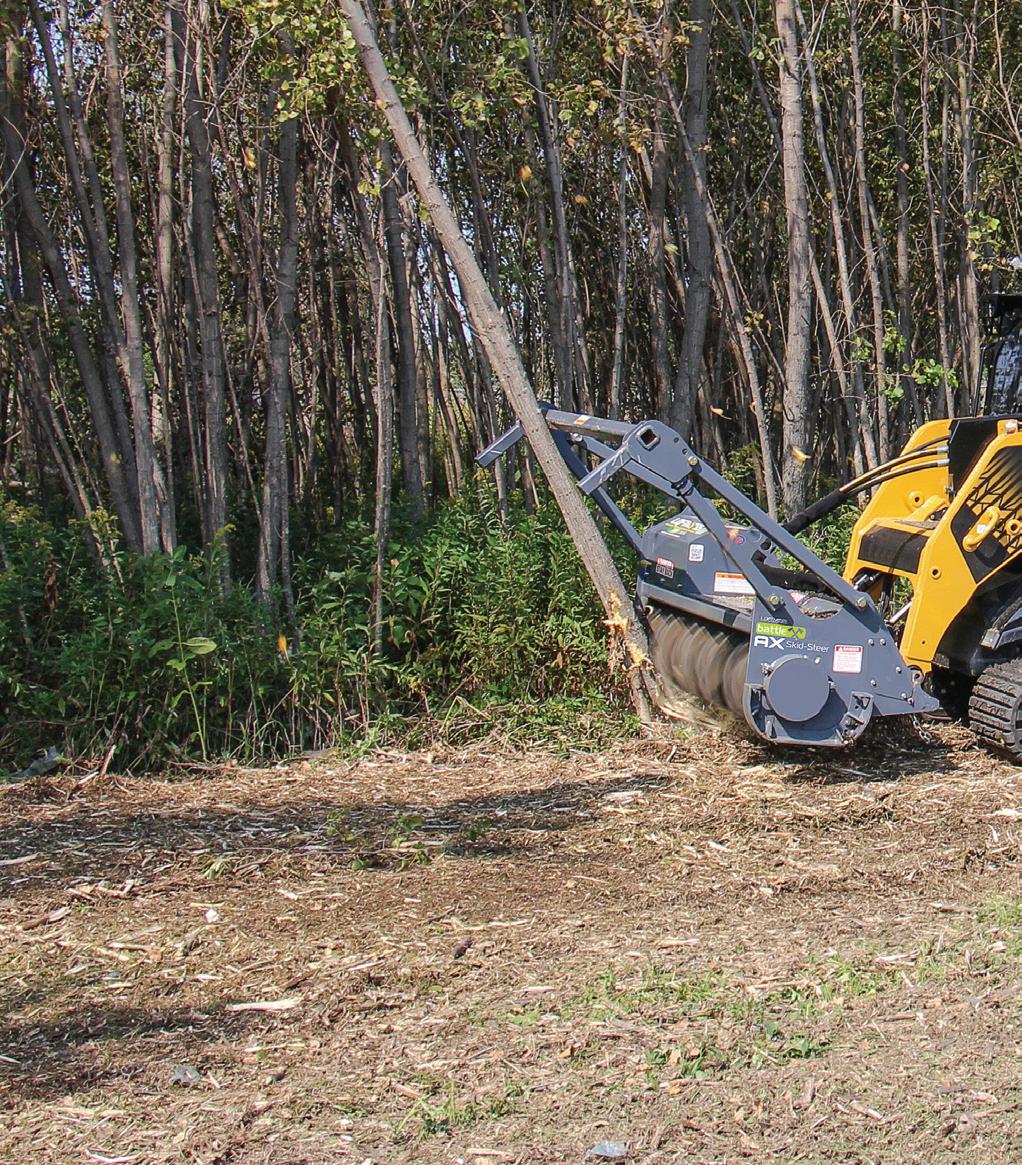
• ECU-controlled power management system adapts and controls motor displacement to produce instant torque and optimal mulching performance
• Can be tuned to any machine in seconds using Bluetooth and a smartphone app or with the in-cab monitor
• Direct drivetrain puts all available power to the rotor
• Head on the M60-S produces up 780 ft.-lbs. of torque with a maximum rotor speed of 2,500 rpm
M60-C includes a hydraulically controlled dual-mode cutting chamber that offers fingertip control of mulch size and degree of broadcasting desired

The 915E FM is a professional forestry excavator designed for logging, collecting and transporting wood under harsh working conditions, such as forests, wetlands and more. This machine is equipped with a Cummins engine and a coordinated hydraulic system for output and movement. The 915E FM uses specific protection for forestry and a 960-mm-wide single-grouser track. The minimum ground clearance is up to 600 mm for safety and low grounding pressure for travelling in the forest.

The ME36 and ME50 are suited for right-of-way maintenance and fire/fuel reduction as well as clearing standing or felled trees and brush along fence rows, roadsides, waterways and other hard to reach places.
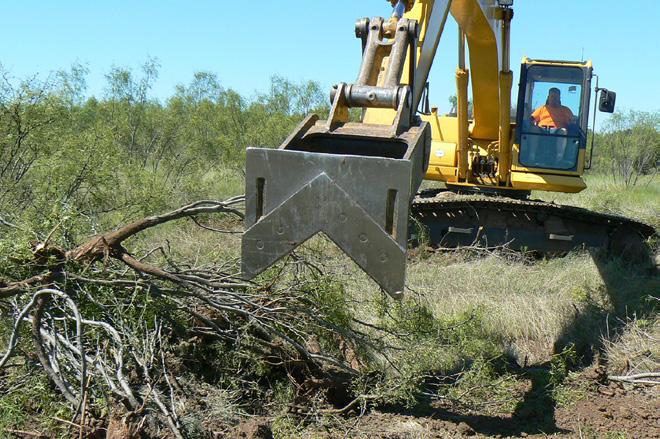

• Knife-style cutting teeth on a split ring rotor
• Spiral double helix tool pattern and tool shape allow for efficient cutting of up to 5-in. material
• Controlled and metered cutting depth allows the operator to maintain high rpms and a productive mulching rate

• Teeth may be sharpened and flipped
• Tested and optimized to work with the company’s excavators and compatible with many competitive 5-ton to 10-ton models
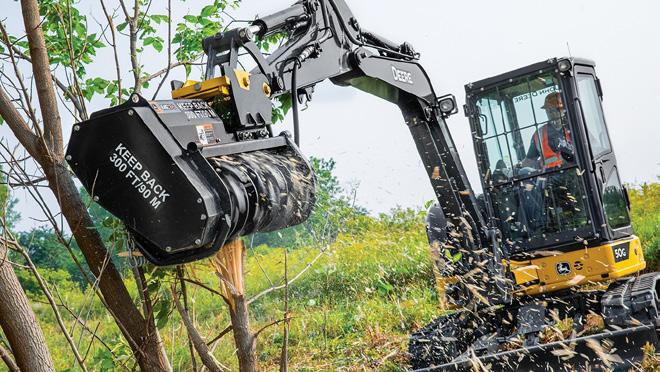

The Grubber slices roots and extracts brush in one easy motion and is available in models to fit most excavator sizes and classes including minis.
Constructed with a heavy-duty upper channel, AR400 steel cutting edges and triple pass welds on the high-stress areas
• Available with a replaceable bolt-on edge V-edge or straight edge
• Suited for select extraction of brush and nuisance vegetation
• Minimize ground disturbance, reduce erosion and promote grass growth
Powered by the 104-hp Cat C3.6 Tier 4 Final/Stage V-compliant diesel engine, the D1 Mulcher includes closed-loop hydraulics and upgraded screening that optimize performance while clearing a mix of small- to medium-diameter materials in a 72-in.-wide strip with each pass. The unit is design-matched with the rugged HM518 mulcher, which has a drum speed range of 2,150 to 2,450 rpm and comes with 38 fixed teeth featuring a single-bolt carbide tooth retention design. Its pressurized, heated and air conditioned cab includes mulcher controls mounted on the air suspension seat, a 10-in. color touchscreen monitor with standard reversing camera display and an in-cab drum indicator for monitoring drum speed and direction at a glance.
The 135VRT has a 4,150-lb. rated operating capacity with integrated counterweight or hydraulic winch kit, and is powered by a 132-hp Cummins 3.8L Tier 4 Final engine. A 50-gpm auxiliary attachment flow provides 119 hp to the VM602SS Bull Hog Forestry Mulcher or other attachments; a 16-gpm reserve allows full machine control without loss of attachment performance. A bite-limiting rotor is fitted with 30 carbide or doublesided tools and maintains rotor rpms to easily mulch material up to 8 in. in diameter. An improved loader arm design enhances attachment visibility. The full forestry spec cab includes 1/2-in. polycarbonate side windows, a Level 2 FOPS and a complete guarding package, while the more spacious, comfortable operator station includes an 8-in. color display.
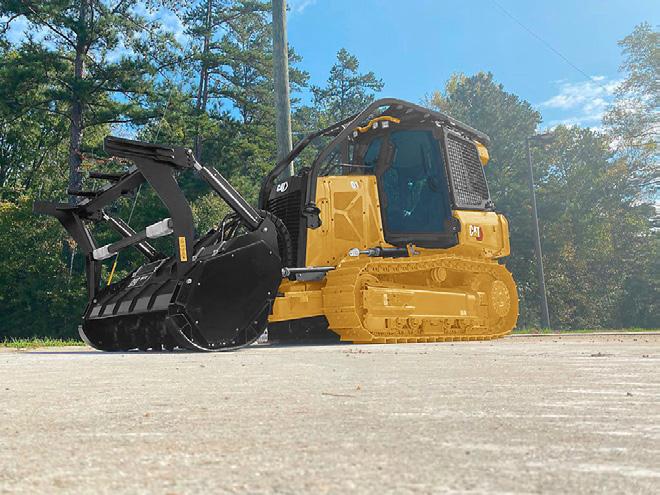
Danuser’s EP Auger System for backhoes, mini skid steers and excavators feature a planetary gear drive that is up to 42% stronger than the competition with greater torque for drilling through hardcompacted surfaces. It is available in a wide array of models, ranging from 6 to 35 gpm and from 1,500 psi to 3,500 psi.
• Accessible check and fill plugs
• Swings from a knuckle to allow left to right, forward to back leveling
Most vehicles with 72-in. or greater hinge pin height may use standard 4-ft. length augers. Hinge pin heights of 71 in. or shorter require 3-ft. length augers maximum
• The output spindle is manufactured as a single piece, allowing Danuser to offer a lifetime warranty covering output spindle pullout
Vermeer has introduced a redesigned version of the HG4000 horizontal grinder. This new generation of the HG4000 delivers performance in various wood waste recycling applications and landscaping material production. It’s equipped with a 536-hp (399.7-kW) CAT C13B T4F Stage V diesel engine, a Series III duplex drum, an infeed to accommodate a variety of materials and many performance and durability features. It has a working sound level of 112 decibels. The HG4000 has a feed table capacity of 4.6 cu. yd. (3.5 m3). It features the cutting performance of the Vermeer patented Series III duplex drum with reversible hammers and tips for reliable wear life, compared to singlesided designs, while offering bolt in replacement parts. The hard-faced anvil on the HG4000 delivers cutting action with the drum and a redesigned anvil-mount structure minimizes the hard-faced wear edge replacement process.

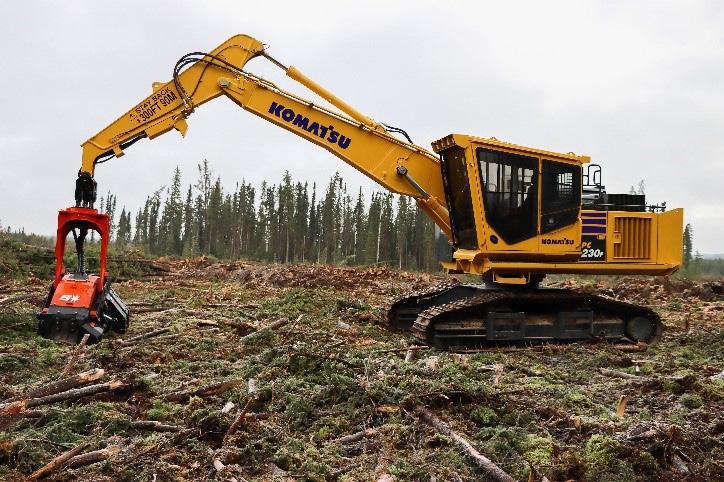
Purpose-built for processing applications, the 197-hp PC230F-11 has a rugged design, high and wide undercarriage, a powerful swing motor and is designed to withstand high-debris conditions. The wide-fin radiator is covered by heavy-duty forestry screens, and a variable pitch reversing fan helps promote airflow. With a powerful swing system and a large swing circle, trees can be moved with the PC230F-11. Its reach of up to 29.3 ft. (8,951 mm) and maneuverability help support operations. This machine features a Komatsu SAA6D107E-3 Tier 4 Final engine. Operators can adjust to a sudden change in load weight with the Auto Power Max feature. It automatically senses the difference and reacts with an 8.5-second burst of additional horsepower to help pull the trees through during the delimbing process.


SEPPI has launched its latest mulching equipment: the MAX 50 le, a mulcher than can be operated by remote control, the MICROFORST cl compact mulcher for skid steers or compact track loaders and the MINISOIL cl that crushes stones and mulches wood. The MAX 50 le can be operated from a safe distance by using a remote control that displays key machine data like fuel, rpm and speed. The MICROFORST cl is a compact mulcher that can attach to any compact track loader or skid steer loader that delivers between 13 gpm and 27 gpm of hydraulic flow. The MINISOIL cl takes the power of a PTO stone crusher and mulcher and brings it down to size for skid steers, compact track loaders and hydraulic tractors that deliver at least 28 gpm to 66 gpm of hydraulic flow.

IronCraft redesigned its Forestry Disc Mulcher, which is capable of eradicating 6-in. to 14-in. diameter materials and standing or felled trees. A 60-in. fully machined disc includes 44 beaver teeth located on the top, bottom and perimeter of the disc, with five additional beaver teeth located on the inside of the deck for mulching capacity. An angled throat design guides material into the mulching chamber to support the shredding of brush. This mulcher is available with either 150-cc motor that requires 32 gpm to 44 gpm of hydraulic flow or 200-cc motor that requires 45 gpm to 60 gpm of hydraulic flow. All models feature a 1-in. hinged deflector and 0.375-in. thick deck with reinforced sides.

Diamond Mowers offers the Belt Drive Disc Mulcher for contractors and mulching professionals. The attachment features reliable torque and promotes low hydraulic temperatures for uptime and carrier life. Forward visibility for contractors minimizes the possibility of hitting obstacles and enables positioning vegetation for performance. Featuring a 60-in. cutting width, this attachment slices through trees and brush up to 14 in. in diameter, shreds material up to 6 in. in diameter and attaches to most skid steers and compact track loaders. While Four-Point Hardened Steel Teeth come standard, users can swap them for Twin Maul Carbide Teeth to absorb impact and apply the right bite for various applications.
The Mini Skid Steer Quick Attach Frame for Mini Track Loaders includes a Common Industry Interface (CII) loader quick attach, enabling use with a variety of brands of mini loaders, including Bobcat, Boxer, Ditch Witch, Kanga, Ramrod, Toro and more.


• Designed for a maximum load of 3,000 lbs. at an 18-in. load center, depending on fork tine capacity
• Frames can be used with the company’s pallet forks, grapples, stump buckets, hydraulic plow and more
Built using high-strength steel with MIGwelded construction
• Baked-on powder coat augmented by a proprietary graphite coating on the fork rails for easier sliding of forks
• Includes a built-in 2-in. receiver
Mecalac’s new product line of compact loaders to the North American market is comprised of six models, including the MCL2, MCL4, MCL4+, MCL6, MCL6+ and MCL8. The series offers performance for industries ranging from agriculture to landscape, forestry, snow removal, utility and construction. The M-Drive and speed control features allow the loader to function as a tool carrier, providing control of rpm by hand throttle and speed via a foot pedal. This enables controlled operation of a wide variety of hydraulic attachments. Each MCL in the series has an option for auxiliary hydraulic lines on the boom and at the rear of the machine, as well as 12-volt three-pole plugs, allowing the ability to use hydraulic attachments on either end of the machine. The MCL series maximizes attachment possibilities with 7.9 gpm flow on the MCL2 and MCL4 models and 15.9-gpm flow on the MCL6 and MCL8 models. Each machine has a 45-degree articulation that keeps the front wheels traveling in the same path as the rear wheels while driving. A 10-degree oscillation allows a stong follow up and maximum traction wherever the machine might travel, including on uneven ground. Each machine in the MCL series offers transportability between jobsites with low transport weight, which ranges between 3,836 lbs. and 6,283 lbs.
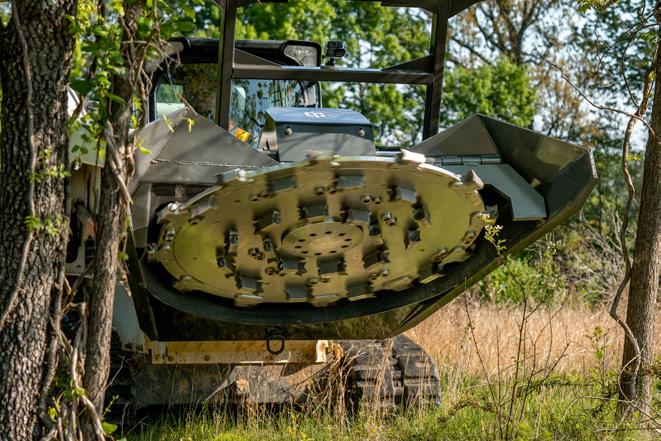
The overall importance of having the right tires on jobsite equipment and maintaining them properly cannot be overstated. Maximizing uptime and increasing efficiency is always top of mind for construction fleets, and both factors are directly impacted by a fleet’s tires, noted Robby Hamby, Bridgestone America’s director of commercial product strategy.
“These tires are asked to navigate challenging surfaces and conditions, making the equipment vital for operations,” Hamby added.
Bridgestone has invested heavily to advance tire technology and digital solutions to help fleets get the most out of their equipment and to arm operators with data to help them make informed decisions, Hamby pointed out, adding “keeping a vehicle’s tires healthy and at max performance allows jobsites to move forward.”
“Most jobsites today cover large areas, meaning it is crucial for the crews to be able to maneuver around the site safely and efficiently,” noted Cory Trombley, NHT North America regional sales director for Nokian Tyres. “Wheeled machines allow job crews to do just this.”
“Tires play a crucial role in ensuring the safe and efficient operation of construction equipment,” noted Scott Holub, BKT manager, offthe-road (OTR) technical services. “Properly functioning tires can stabilize heavy machines and prevent accidents from occurring on jobsites.
“Tires that are well-maintained and replaced when necessary can help reduce downtime by preventing breakdowns,” Holub added. “Additionally, with the correct tire, contractors can impact fuel consumption, operating costs and overall productivity.”
“Having the right tires will ensure that the application has the best performance to do the job,” said Molly Chen, MAXAM Tire North America spokesperson. “Tires should be maintained along with the equipment itself as they provide support for the application.”
Tire options abound in the marketplace. Bridgestone offers a wide variety of tires for construction fleets, all of which are designed to help drive uptime, Hamby said. Bridgestone’s portfolio of construction tires includes the Bridgestone VMT and the
Firestone Duraforce MH, two products designed with enhanced tread patterns for traction and high performance in construction.
The company recently announced its new 25-inch VZT construction tire at 2023 CONEXPO-CON/AGG. Used for loader and grader applications, the VZT is designed to enhance key performance attributes to help maximize productivity and provide traction while improving on its smooth, comfortable ride, Hamby said.

Nokian Tyres offers premium block-pattern and flotation tires for the construction industry.
“Our tires are designed to offer end users long working hours and high-load capacities as well as a more comfortable ride when moving around the jobsite,” Trombley said.
MAXAM Tire manufactures tires for a variety of construction applications, including skid steers,
backhoes, telehandlers and pavers.
Chen noted that the tires are designed with high-quality materials and engineered to provide the lowest cost per hour.
BKT offers tires for a wide range of construction equipment including excavators, bulldozers, loaders, graders, dump trucks, and more.
Tires for Electric Equipment
More electric vehicles (EVs) are coming on the scene. As states such as California set the stage for carbon emissions reduction, some tire companies are answering the call for EV-appropriate tires.
Hamby noted Bridgestone’s line of premium construction tires and integrated technologies are EV-compatible.
“Our team of engineers is continually looking for ways to innovate and develop new products with EV technology in mind for commercial fleets,” he said. “It’s important to note that tires for electric fleets can exhibit different wear and replacement cycles, but with the proper settings and the latest technology, that wear cycle can be controlled.”
BKT recently introduced its first E-READY tire line, the Agrimax Factor, in response to a growing trend toward EVs in the construction industry.
The Agrimax Factor is designed for tractors and features reinforced side walls, a stronger bead package and an updated tread compound.
“In the future, BKT will look into expanding the E-READY tire line to additional applications,” Holub said.
Tires for electric vehicles must be different from traditional ones because EVs weigh more since their batteries may add up to 30% extra weight, which
can affect tire performance, according to Piero Torassa, BKT field engineer manager at BKT Europe.
Tires also must withstand higher drive torque, especially at the start, Torassa noted, adding it is necessary to revisit the tire’s bead structure to ensure better grip on the rim, especially during acceleration. The tread also be optimized in design and compound.
Tires mounted on an EV that are inadequate can cause significant energy losses, since rolling resistance can contribute as much as 20% of the vehicle’s energy consumption, according to Torassa.
Subsequently, it is necessary to adapt the tread compound, tread pattern and sidewall structure. Tires used for EVs should have different tread patterns and compound compositions, both natural and synthetic. Size also significantly contributes to a tire’s quietness, Torassa pointed out.
Selecting the Ideal Tire for an Application
An equipment operator should consider many factors when choosing a tire for construction site work. Focus on understanding the job conditions in which the equipment will operate when selecting a tire for construction site work, Chen said.
“For example, will the equipment be on soft underfoot conditions in mud? Or will it be operated on icy roads? What is more important to the contractor?” Chen added.

“If it is off-roading, consider the load-carrying capacity. Does the
contractor prefer radial or bias? Does the contractor worry about puncture? Many variables come into play other than size and pricing. One must consider the condition the equipment operates in and choose the right tires accordingly.”
Trombley echoed the point that the biggest key when choosing a tire is making sure to select the right tire for the application, adding that it is important to make sure the tires are rated for the type of environment in which they will be used.
Equipment operators should choose a tire that offers excellent traction, stability and durability, Holub said. “With that being said, it is important
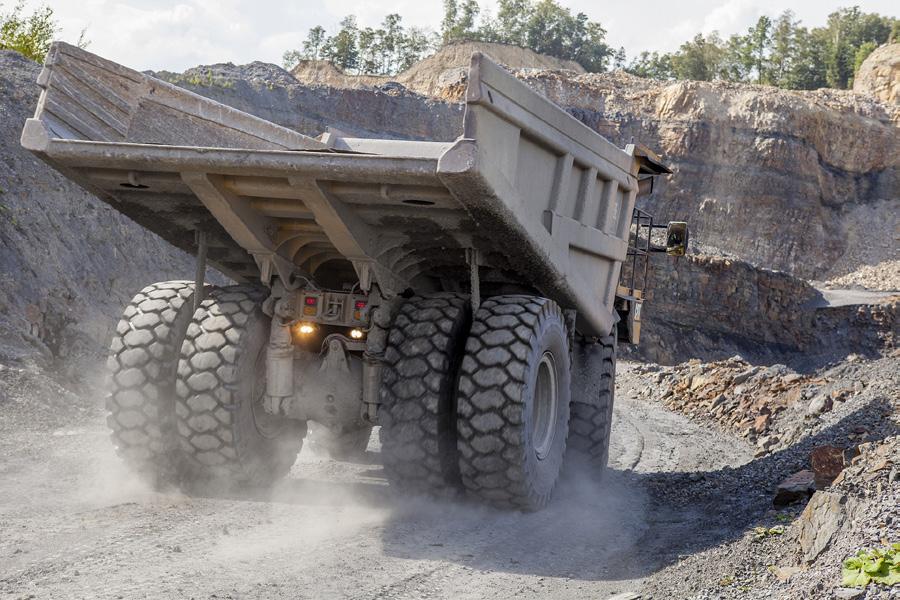

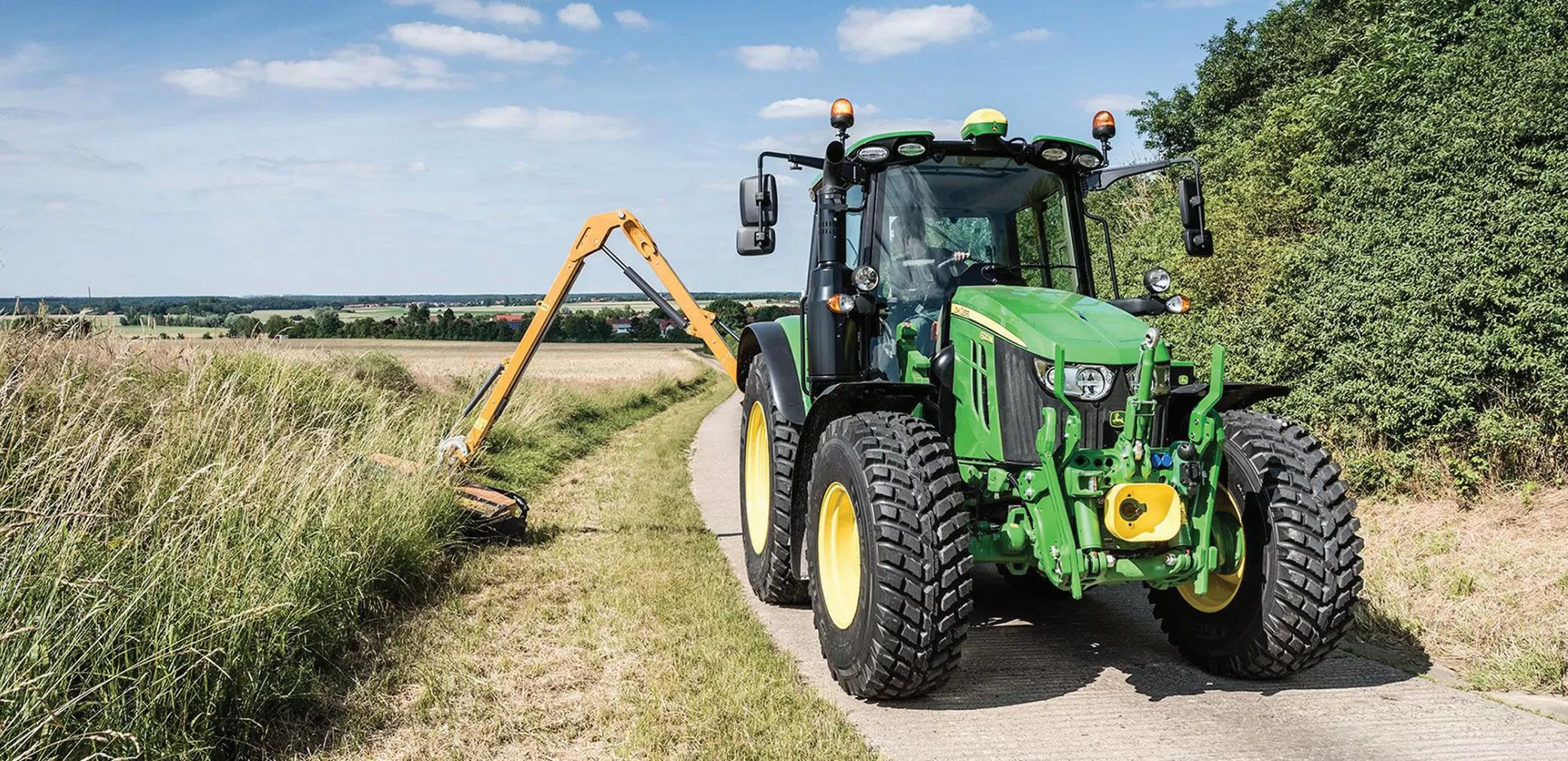
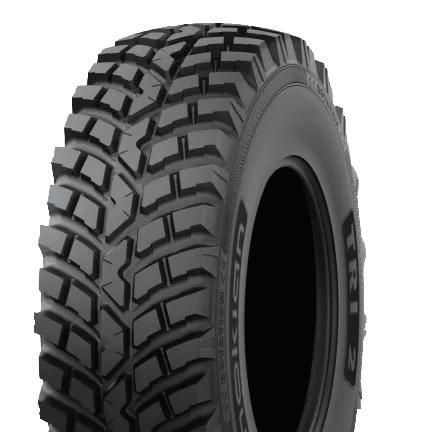
Nokian Tyres TRI 2 excels in a wide variety of tasks from job sites to highways, from snowy winters to hot tarmac. Its durability, economy and comfortable driving response make it a reliable choice for versatile contracting work.
nokiantyres.com/heavy
Tires play a crucial role in ensuring the safe and efficient operation of construction equipment.
to keep in mind many factors, like application, type of equipment, load and speed, before making a final decision,” Holub added.
Hamby said that it is important to understand the site conditions in which the equipment in the fleet will operate when deciding. Bridgestone’s network of 2,500 authorized dealers helps evaluate this information
and recommend tires based on the conditions, he added.
Asset management capabilities are also worth considering, said Hamby, adding that Bridgestone offers solutions and technologies designed to enhance the ability of an equipment operator to properly monitor tires on a construction fleet.


“Our tires are manufactured to seamlessly connect with digital
health-monitoring solutions like IntelliTire that monitor a tire’s attributes in real-time,” he said. “By pairing tire monitoring solutions with premium tires, equipment operators can detect and avoid tire issues before they happen, maximizing their investment by extending the life of the tire.”
Hamby pointed out that “increasingly, forward-looking fleet operators are looking at tires not simply as a cost to be managed but as an investment to be maximized, realizing that tires are integral to an optimally safe and efficient fleet.
“By pairing … Bridgestone tires with data-driven insights, our Bridgestone end users are seeing how the right tires and data can drive significant, bottom-line efficiencies as well as sustainability in their daily operations.”
Today’s Tire Technology Tire companies are now offering technology enabling equipment for operators to identify tire problems before they develop. The best way to maintain tires is to prevent downtime before it happens with health
Routine maintenance is not only vital to the health of tires but also to overall fleet efficiency, said Bridgestone America’s Hamby. “Tire-related downtime can result in significant financial and operational costs, so it is important to maximize the investment and get the most out of the tires,” he added.
Basic tips for maintaining tires:
˜ Regular tire inspections should be performed to look for any damage (cuts, embedded materials, torn lugs, bulges and cracking) that could impair the equipment operation.
˜ For radial tires, always check the air pressure to ensure that it is at its optimal pressure according to the manufacturer, said MAXAM Tire North America’s Chen. “Air pressure for each application is determined by many different factors, and just as we all know, a tire cannot perform without air,” she said.
˜ BKT’s Holub added, “In addition to looking for damage during the inspection, contractors should check air pressures weekly, as improper air pressure by as little as 5 pounds can reduce the performance and life of a tire.”
˜ “Proper pressure maintenance is crucial and must be done regularly,” said NHT North America’s Trombley. “Overloading is one of the main causes of early failures in tires, so as an industry we need to do everything we can to educate end-users on the importance of checking air pressures regularly.”
˜ Cold inflation checks are the best and most accurate. A cold tire is generally defined as one that has been sitting idle and not used for a minimum of 24 hours, said Chen, adding from this point, the pressure can be monitored more accurately.
˜ “Hot inflation checks in most cases are the norm since many operations are 24/7,” she said. “Therefore, knowing the cold inflation pressure of the tire will help track the rise in pressure in a working tire. This will then help to set the correct standards for warm inflation checks.”
˜ For certain tires and applications, rotating the tires may be required to maximize life, noted Holub.
˜ Use a tire gauge if needed.
monitoring solutions like IntelliTire, said Hamby.
The digital solution is a remote health monitoring system that uses internal or external stem-mounted sensors to provide critical real-time data such as tire inflation pressure and temperature to continually monitor the health of each tire throughout its life cycle, he added.

“The data gathered by this tool help fleets reduce downtime by scheduling maintenance when needed, optimize total cost of ownership, and maximize productivity,” Hamby said.
BKT has developed a device called SPOTech (Satellite Performance Optimization Technology). SPOTech uses GPS, accelerometers, video cameras and data loggers during site visits to record distances, cycle times and speed. BKT combines that information with the customer’s production data to calculate which tires will perform best. This helps optimize a customer’s operation and reduce maintenance issues, said Holub.
Nokian Tyres recently launched its own tire monitoring system called Nokian Tyres Intuitu.
“Our goal with this program is to offer our customers ‘Smart Tires,’ giving them the ability to track the performance of their tires right from their phone,” Trombley said.
Tire Maintenance
MAXAM Tire has a series of technical bulletin articles to help end users maintain their tires and understand how to choose the right tire. The company advocates daily maintenance checks on tires, making the point that it’s important for construction companies to do so to derive optimal productivity and life from them. Basic inspection points include the tire’s external appearance, rims and valves, and inflation pressure.
Additional signs of damage include punctures and cuts. Small, hard objects can penetrate the tread, casing and inner liner, resulting in loss of air and casing strength. If the damage is caught early enough, the tire can be repaired. If the cut is too deep, the tire should be scrapped.
Separation of the tread from the belt or casing ply is another sign of damage. It is caused by normal shear forces in a working tire after being cut. Small cuts can transform into separation over time, resulting in heat build-up and subsequent increases in the size of the separation. If caught early, the tire can be repaired. If not, it must be scrapped.
Heat separation is caused by excessive brake heat and loads, causing tread or bead area separation, with the rubber giving off a burnt smell. Operators should stay within ton-mile/hour requirements and monitor loads.
Turn-up separation is caused by excessive shear and/or bending force in the bead area, resulting in excess load and causing the tire to bend over the top of the flange.
The result is heat buildup and subsequent separation, although it may also be a manufacturer issue. The issue can be addressed through proper and evenly distributed loading of the

vehicle. The tire should be removed once the steel is showing.
Impact breaks are caused by excessive impact energy loading beyond breaking the strength of the casing. It results in immediate air loss—blow out—or damaged cords, causing separation. The tire should be scrapped, and the operation should
focus on improving clean-up and proper operation.
Read more at: https://eqtoday.co/ykg6jh
No matter how challenging your needs, EARTHMAX SR 41 is your best ally when it comes to operations that require extraordinary traction. Thanks to its All Steel radial structure and the special block pattern, EARTHMAX SR 41 provides excellent resistance against punctures and an extended service life. In addition to long working hours without downtime, the tire ensures extraordinary comfort.
EARTHMAX SR 41 is BKT’s response to withstand the toughest operating conditions in haulage, loading and dozing applications.

Vehicle electrification remains a hot topic. In his annual letter to stakeholders, BlackRock’s CEO Larry Fink asserted, “The next 1,000 unicorns won’t be search engines or social media companies. They’ll be sustainable, scalable innovators who help the world decarbonize and make the energy transition affordable.”
Off-highway electric vehicles (EVs) are witnessing high adoption across industries globally as governments aim to reduce carbon emissions and offer rebates and tax incentives to deploy these types of vehicles on jobsites
They are reaping some of its benefits: fewer fumes, noise, emissions, and decreased energy costs and operating costs. While electrification in construction equipment is expected to grow globally, barriers remain.
Many incumbent vehicle manufacturers and component suppliers are grappling with how they can best respond to an increased demand for EVs in the construction industry, disrupting their traditional product offers and business models in the pursuit of maintaining market share in this market shift.
While the path forward is necessarily different for every company, construction equipment


manufacturers that focus on these three key areas — customer value creation, product and technology planning and development, and financial performance and potential— will do the best at speaking to a growing segment of contractors looking to electrify jobsites.

Many fleets have made bold sustainability commitments and goals—and at the same time remain committed to improving total cost of ownership, end-customer satisfaction, and their own employees’ satisfaction. To deliver against all these goals, much will have to change.
No one player has “cracked the case” on an end-to-end electrification solution—but those who focus on first becoming experts in their customers’
end-to-end production processes are the likely winners.
Partnering with customers to understand priorities and to define jointly how their processes can evolve for electrified vehicles will be key to achieving market adoption. For example: How will electricity be generated and transmitted (for example, at the depot or the jobsite)? How will EV drivetrains impact vehicle uptime and duty-cycle performance, and what compromises may need to be made?
This range of issues spanning customers’ processes and how manufacturers and suppliers will address these needs can be tackled with a master plan that clarifies a wide range of issues. Distinct vocations with disparate dutycycle requirements—for example, mining and construction equipment—necessitate offering a portfolio of solutions to address customer segment needs.
Investors recognize the imperative to shift to electrified vehicles and are also beginning to recognize what manufacturers and suppliers have known for years: there is no one-toone conversion of profit pools.
Take, for example, aftermarket parts sales, a high-margin annuity that many manufacturers and suppliers rely on to drive earnings performance. Battery electric drivetrains require fewer parts and have far less frequent maintenance and repair needs (no oil and filter changes!) as compared to conventional internal combustion drivetrains. To offset this decline, a whole new portfolio of services can both strengthen endcustomer relationships, complement EV products in the construction industry, and deliver new profitable growth annuities — for example battery leasing programs, charging infrastructure financing and installation services, maintenance and repair outsourcing services or technician upskilling programs, and more.
The journey to mass-market EV adoption in the construction industry is still long and far from over. While it comes with many challenges, companies that act quickly to rethink how they can position themselves to deliver customer value will be rewarded favorably.
Read more at: https://eqtoday.co/9x3bl2
Manufacturers are providing electric options.Hans Mueller-Schrader is an engagement leader. Richard Schwartz is a partner at Treacy & Co. by Cherry Bekaert. Companies that act quickly and boldly to rethink how they can position themselves to deliver customer value will be rewarded with favorable perceptions among investors. Treacy & Company by Cherry Bekaert
The largest and fastest growing trade show for the utility infrastructure and construction industry is back. Experience the latest technologies, innovations and trends through live talks and hands-on demos in our expansive layout.


safer, faster ways to complete difficult, dangerous, labor-intensive tasks. Their solution was to mechanize manual processes and deliver a powerful but compact machine in an electric package. Today, these manufacturers have experience engineering electric equipment and have optimized machines for the best power and performance.
Remote-Controlled Demolition Robots
Demolition applications are demanding to say the least. They are dangerous. They often require the power of large equipment but pose a host of challenges that make it difficult to impossible to actually use it. Some of the common issues contractors contend with are limited access, confined spaces, low floor loads and nearby occupied spaces.
In the 1970s, there were not a lot of options for solving these kinds of problems. Confined access? Send in workers with hand tools. Confined access but overhead work? Put them on ladders or scaffolding with the hand tools.
doorway, fit in a passenger elevator or even climb stairs.
But don’t let the compact size fool you. Demolition robots are engineered starting at the tip of the breaker for maximum hitting power. The result is that pound-forpound, demolition robots provide the highest power-to-weight ratios in the industry, delivering the same results as an excavator three times the size. Combine that with a three-part arm, an electric-powered demolition robot offers exceptional reach and power in all directions, providing maximum precision and accuracy while the operator works from a safe position.
Alternative powered equipment is a hot topic. You can’t pick up a magazine without seeing an article about electric excavators, skid steers, telehandlers, wheel loaders, cars and more. With the world paying attention, it’s easy to forget that other types of electric equipment have existed for years—and, in some cases, decades. As many manufacturers have proven, it’s not overly difficult to
come up with an electric model. Virtually all the large and midsize heavy equipment brands have at least one. The real challenge is optimizing performance, especially in heavy duty applications. Does the product have the power to get the job done? Can it make it through a shift?
Decades before these questions entered everyday conversation, demolition equipment manufacturers were innovating to meet demand for
Too much noise? Deal with it. That’s the way it is. From the need for safer, more efficient demolition methods, the first remote-controlled demolition robots were born. While some diesel models are offered today, demolition robots started electric and remain electric more than 45 years later.
Today’s machines look like small excavators with a three-part arm that often wields a breaker, but can use a variety of attachments, including concrete crushers, scarifiers, shears, splitters, buckets, grapples and more. Robots range in size from 23.5 inches wide and 1,235 pounds to 84.65 inches wide and 25,133 pounds. The smaller robots can drive through a standard
A variety of attachments further increase the value of compact electric power. Equip the robot with a shears attachment and efficiently and safely tear out concrete reinforcement, sprinklers, conduit, wire and cables. Or use a concrete crusher for “silent” demolition. The crusher attachment “chews” down a wall as opposed to using the force of a breaker to knock it down, reducing noise and vibration. For top-down applications where noise and vibration are primary concerns, crushers allow contractors to work during the day, sometimes without neighbors noticing.
These capabilities have years of experience behind them, making electric demolition robots the go-to for everything from soft demolition to refractory removal, ladle cleaning, underground mining, tunneling and many unique applications, such as driving helical piers.

Hydrodemolition robots were not far behind demolition robots. They were first developed in the 1980s to provide a better, faster way to remove large amounts of concrete. Like demolition
robots, the first hydrodemolition robots were electric models, with diesel models following.
If you aren’t familiar with hydrodemolition, it is a concrete removal method that uses highpressure water jets to penetrate pores and small cracks in the material and break it out. A significant benefit is that it can remove weak or damaged concrete while leaving good concrete intact. It is commonly used for repairs on bridges, parking garages, tunnels, dams and other concrete structures.
Back in the 1980s, hydrodemolition manufacturers were innovating to improve a slow, difficult process that took a lot of manpower and was very hard on both the workers and the concrete structure. By harnessing the power of water, they developed an impact-free process that eliminated the vibrations that cause microfractures—miniscule cracks in sound concrete that can compromise the structure’s integrity. The highpressure water jets also clean rebar and metal reinforcement without damaging it. And the process is much faster, with a single robot and operator achieving the same removal rate in a day as 20 jackhammer operators.
Today, the smallest models are electric while the large models are diesel, electric or hybrid with the use of a hybrid kit. The benefits of hydrodemolition apply regardless what model a contractor uses, but there are certain situations in which an electric model is advantageous. A tunnel repair would be one of them. If diesel equipment is used, the contractor must provide a detailed plan for proper ventilation to win the bid and then implement the plan, which adds another layer of logistics and cost to the project. By using an electric
hydrodemolition robot, the contractor eliminates concerns about air supply and ultimately saves time and money.
Solutions also exist for contractors who need the capabilities of a large robot but are unable to use diesel power. Maybe the project is inside a building. The market offers bigger robots with an electric-powered option for these situations. Just like a diesel-powered hydrodemolition robot, electric units can efficiently remove large amounts of concrete and reach horizontal, vertical and overhead areas up to 7 meters (23 feet)
without support. On top of zero emissions, an electricpowered robot runs more quietly, making it an ideal option for projects with exhaust emission and noise restrictions. Some manufacturers also offer hybrid kits that allow a diesel hydrodemolition robot to run on electric power. The kit disengages the robot’s diesel engine, transforming it to an electric-powered machine, much like a hybrid car. This gives the contractor options, depending on what the project calls for, and provides a good back-up if the diesel power breaks down in the middle of a project. The contractor can simply plug in the hybrid kit to keep the operation moving.
In the demolition world, electric solutions are nothing new. For many demolition and hydrodemolition contractors, it’s just another day on the jobsite. Manufacturers have developed generations of electric robots, mastering electric power and offering highly sophisticated technology that is used for major projects around the world. For them, the question
Electric-powered demolition robots offer reach and power in all directions, providing precision and accuracy while the operator works from a safe position.
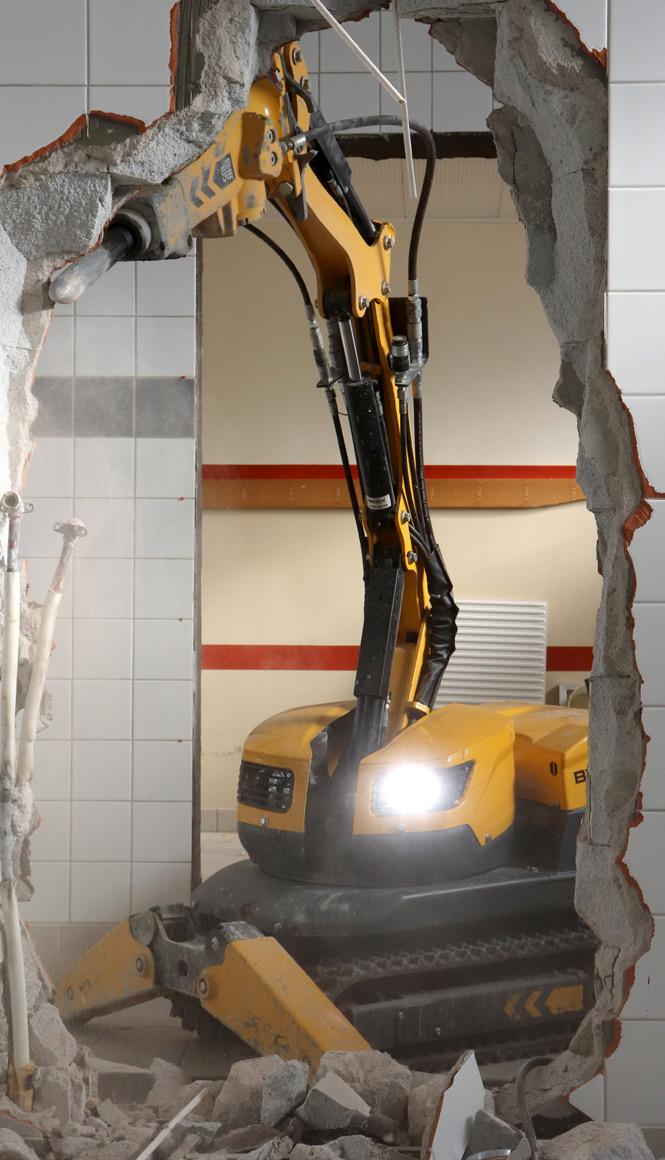


isn’t how to come up with a workable electric solution. It’s how an already well-developed electric solution can further increase safety, productivity and profitability.
Read more at: https://eqtoday.co/x4fsct
The H/E deep-tread skid steer tire is designed for use in severe applications such as concrete planing, asphalt recycling, demolition, quarries, glass plants and scrap yards.


• Aggressive tread depth and diamond lug pattern provide optimal resistance to punctures and wear
• Available in tread depths ranging from 1.375 in. to 1.5 in. and in 10-, 12- and 14-ply ratings
• 10-16.5NHS, 12-16.5NHS, 14-17.5NHS and 33x15.5-16.5NHS sizes
The Traxter range of solid, skid-steer tires features an extra deep tread and specially designed sidewall apertures for shock absorption.
• 100% flat proof with high damage resistance
• Supplied as ready to fit tire and wheel assemblies
• Extra deep tread provides three to five times the service life of pneumatic tires
• Available in a wide range of applicationspecific patterns
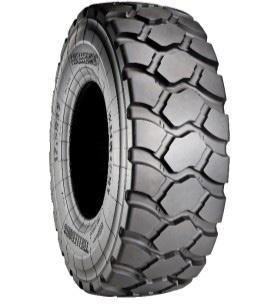

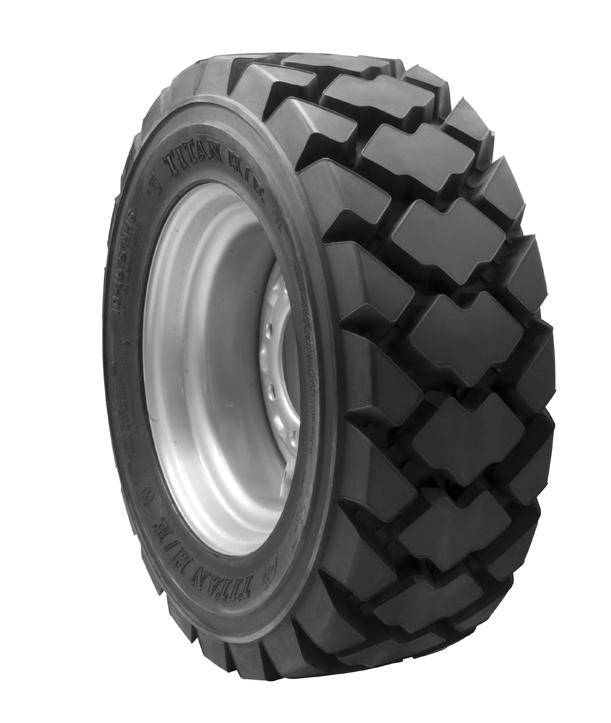
Trelleborg’s newest tire for earthmoving applications, the EMR1031, is designed to perform on sand, rock and other extra hard surfaces. Manufactured using a cut-resistant compound, the tire has a sidewall protector for damage protection and longer tire life, with a multisurface tread design for improved traction. Its cut-resistant compound is 20% more resistant to cuts and wear, reducing machine downtime and resulting in lower operating costs. The deep tread pattern offers longer tire life, enhanced grip and self-cleaning action during use, even on sandy or muddy terrain. To reduce environmental impact, the EMR1031 tire comes with a retreadable casing.
Yokohama Off-Highway Tires has released new tires for skid steers. The new Galaxy AT Grip Steel steel-belted skid steer radial was designed from the ground up in consultation with skid steer operators and industrial tire dealers. There’s an extra sidewall ply on the tires to add thickness and stiffness. Immediately below the bead, a stiff flex-dampening layer directs sidewall deflection away from the rim, reducing damage from lower-sidewall movement. On the surface of the sidewall, twin rim protectors minimize impact and rubbing damage to the tire. The AT Grip Steel sidewall strikes a balance between stiffness and flexibility that allows the tire to reduce bucking and bouncing, while resisting damage and heat build-up.
While most skid-steer loader tires are 10 to 14 in. wide, WolfPaws are 6.6 in. to 8.5 in. wide to provide nearly double the ground pressure.

• Tread pattern designed specifically for use in snow
• Available for hundreds of different machines
• WolfPaws with studs available for extra traction

The Galaxy Mighty Trac ND all-season, nondirectional skid-steer tire is a versatile L-4 tire for use on loose soils, snow and pavement.
• Siped block tread design and 52:48 rubber-tovoid ratio combine enhanced traction on dirt and snow with wear resistance on the road
Open, non-aligned lug pattern on the shoulders provides extra grip in soft conditions and self-cleaning,
• Heavy, stepped centerline blocks ensure smooth roading and minimize wear
• Special cut, chip and abrasion-resistant compound and reinforced sidewall with a rim protector extend tire life
EVOLUTION WHEEL EWRS-HS HARD SURFACE SKID STEER TIRE
Evolution Wheel engineered the EWRSHS series for severe-duty applications where tire wear is the biggest concern. To do this they redesigned the tread pattern to maximize surface area. The EWRS-HS doubled the surface area of the EWRSAT Series to 66% to spread the weight of the machine out. This lowers the pressure per square inch on the concrete, while extending its wear life significantly. Additionally, the EWRS-HS series has deep tread, measuring at 52/32 in. The core geometry in these segmented tires allows them to compress like a pneumatic tire without the bounce.
Double Coin and CMA are pleased to announce the introduction of the REM-2S all-weather/snow radial OTR tire. This hard surface tire was designed for earthmover, loader and grader applications and will debut at CONEXPO in Las Vegas.

Features:
• Heavy siping with offset blocks for traction
• Advanced capability in snow, ice, gravel, and soft, sandy terrains
• Designed for year-round use
• Balanced performance on wet and dry conditions
• Great for snow removal, winter clean up, road clearing
Goodyear has introduced the RangeMax RSDEV, Goodyear’s first electric vehicleready tire compatible with EV and gas- or diesel-powered regional work vehicles. Equipped to handle the high load capacities of EVs, RangeMax RSDEV was engineered to deliver low rolling resistance for fleets regardless of drivetrain. Engineered with Treadlock Technology to promote even wear and long miles to removal, RangeMax RSDEV is the first regional drive tire embossed with Goodyear’s “Electric Drive Ready” designation. Available now in size 295/75R22.5.
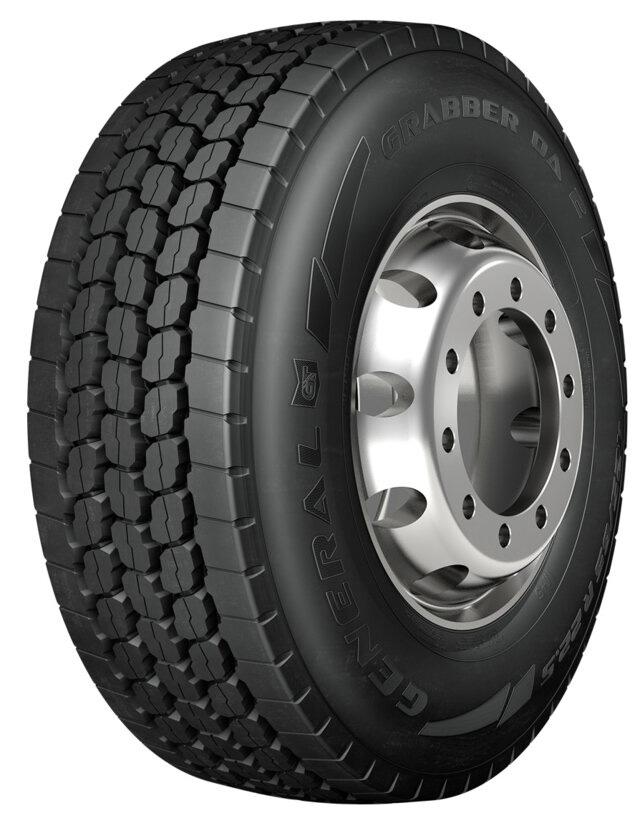

The new VZT 25-in. is the latest addition to Bridgestone’s construction tire lineup. Designed for loader and grader applications, the VZT supports performance attributes for traction and durability. The VZT’s sidewall design provides cut resistance. The VZT will be available beginning in the first half of 2024 in five sizes: 17.5R25, 20.5R25, 23.5R25, 26.5R25 and 29.5R25. Bridgestone will manufacture the VZT in North America at the company’s Bloomington, Ill. OTR plant, as well as in facilities in Japan and Thailand to serve Bridgestone’s global customer base.
The General Grabber OA 2 on- and off-road, all-position tire features 22/32-in. and 24/32in. tread depth and a sidewall profile with curb rib to minimize damage from curbing, cuts and abrasions. The patented groove technology leads to minimum stone retention through a stone ejection system and extends casing life. The tire casing is constructed with four belts and a closed-shoulder four rib tread design, supporting all wheel positions. Drivers should see up to 19% mileage improvement and up to 5% chip and chunk resistance with the new General Grabber OA 2 when compared with its predecessor. This tire can also be sold with a sensor, which connects many of Continental’s tire pressure monitoring systems including ContiConnect Live and ContiConnect Yard Reader to read tire pressure and temperature. These heavy-duty tires can be used on coal or waste haulers, logging, construction, school buses and any on- or off-highway fleets. The General Grabber OA 2 includes a full warranty which guarantees three retreads or six years, whichever comes first.
BKT has developed the RIDEMAX FL 615 radial flotation tire is designed for free rolling wheels of trailers, tankers and spreaders.
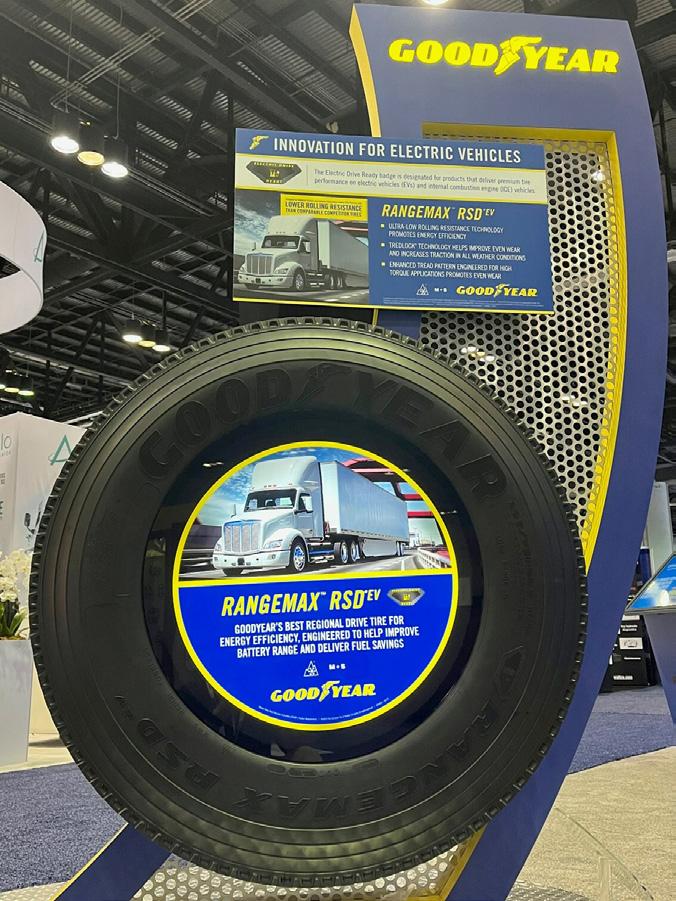


As the construction industry moves toward zero emissions with large equipment, pressure to minimize or eliminate the use of diesel generators is increasing, including decreasing or eliminating their use for site lighting.
As with diesel internal combustion engines, these generators will continue to be used for the near future. However, for lighting jobsites, other options are available that can help contractors begin the move away from diesel lighting solutions. This
includes other solutions that are also not traditional tower lights.

Many operational, monetary and environmental reasons exist to move away from diesel-powered light sources. According to Rob Brockel, senior director marketingGlobal Industrial & Mobile, Generac, “Historically, diesel-powered lighting has been the go-to choice for construction sites due to its reliability, accessibility and ability to operate for extended periods. However, it’s not without its drawbacks, and the advent of innovative alternatives has resulted in a substantial change in the mobile lighting market landscape.”
Among these drawbacks are maintenance and refueling, carbon emissions and noise.
Dan McKenzie, president of Progress Solar Solutions, agrees and includes other problems
with diesel-powered lighting such as running fuel trucks through operations, the cost of constantly burning diesel, fuel delivery costs, the labor to operate the generators and the cost of environmental cleanup of fuel spills.
Carl Miller, chief operating officer, Blue Vigil sights the poor and sometimes hazardous illumination provided by traditional construction lighting.
“Traditional diesel-powered, light towers are standard for lighting nighttime construction sites. However, they do a poor job of illuminating work [areas] due to the inherent constraint in the tower height and lack of flexibility in placement, which affects the safety and the productivity of the workers. These tower lights typically have a maximum mast height of 25 feet and as such the lights are angled at the work area (sometimes even pointing up at workers on overpasses).”
These angles may lead to hazardous glare and shadows. With today’s brighter LEDs, Miller said, even more glare and shadows impact workers, motorists and pedestrians.
Other Options
Other power and configuration options are available including:
˜ Hybrid configurations that use diesel with solar or battery power
˜ Solar
˜ Batteries (they can be charged during off-hours and while in operation, produce zero emissions, are virtually noise-free and require minimal equipment maintenance)
˜ Hydrogen fuel cells (gaining traction but not yet widely used in lighting applications)
˜ Tethered drones (powered by wall/ shore power, smaller generator or vehicle inverter)
“We make mobile solar light towers that run completely on solar power and batteries,” McKenzie said.
“Our most commonly used models, the SLT-700 and SLT-1400, can operate from Florida to Canada [because] we designed them to have enough solar power and batteries. Our mobile solar light towers can turn off and on automatically with either a photocell (light sensor) or timers reducing labor and fuel costs. They also run silently so your team can work right up next to them without any noise.”
“There are numerous benefits to using alternative power sources for construction lighting,” Brockel said. “Most notably, they are more environmentally friendly, producing fewer emissions and contributing less to noise pollution. In addition, these products can also realize significant cost savings from decreased fuel usage and equipment maintenance.”
Another option is the need for a smaller generator or using an inverter to power a drone lighting system. “The ALED Portable [from Blue Vigil] is much quieter and more energy efficient than current LED light towers … it can be powered by wall/ shore power; a smaller, quieter portable 3,000-watt generator; or a common vehicle inverter,” Miller said.
Flexibility
“Alternative power sources can offer more flexibility

and portability, making them suitable for remote or difficult-to-access sites,” Brockel said. Mobility and ease of use are part of many new lighting sources. The mobility available in the batterypowered towers discussed by Brockel provides easy location and relocation of the towers.
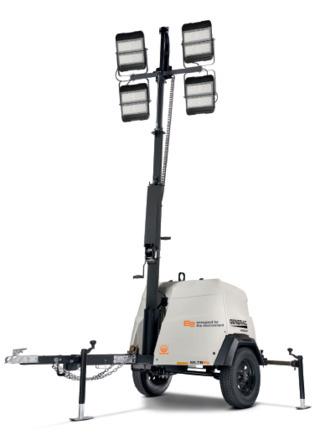
Blue Vigil’s new Aerial LED (ALED) Portable Light uses tethered drone technology to position a high-intensity LED array between 40 feet and 100 feet above a jobsite for as long as needed.
According to Miller, it “puts nearly twice as much usable light on the
ground as traditional towed light towers and does not produce glare and shadows. Its 100,000-lumen LED array produces 8,000 square feet of OSHA-quality, usable light (defined as greater than 5 feet candles) on the ground … By illuminating a work zone from above, light shines directly down

onto the area of operation offering significantly less light spillage without creating dangerous impacts.”
The tethered-drone technology is also person-portable, allowing for more flexibility in transport and setup. It weighs 75 pounds and can be rolled into place by a single person.

“To use, simply open the case, plug it in and use the pendant control
to raise the tethered light up to the desired height (up to 100 feet),” Miller said. “From the ground, the operator can angle the light up to 20 degrees away from center and can adjust the brightness as needed.”
The pushback against new technology is not a novel response. Comfort with known entities is common. One major challenge to the adoption of alternative lighting options is the something-new factor.
“One of the biggest challenges for us to overcome is the market bias against something new,” Miller said.
According to Brockel, sunlight availability, battery recharging and initial investment costs may affect the adoption of alternatives.
“Solar-powered lights depend on adequate sunlight for charging, which might not be reliable in all locations or seasons,” Brockel said. “Batterypowered lights, on the other hand, need to be recharged, which requires access to a power source. Lastly, the initial investment for some alternative power solutions might be higher than traditional diesel lighting, although this cost can often be offset by lower operating costs over time.”
McKenzie agrees with these impediments. “The first [challenge] is purchasing the right equipment that is designed to work year-round in the area you are in. We help customers
select the right unit and sell units with more solar and batteries. The second is setting up the unit in a sunny area with the panels facing south to get the full benefit of the sun.”
While the initial purchase price may be a deterrent, the total cost of ownership is lower for some alternatives.
“Cost savings and reduced labor requirements [are benefits],” McKenzie said. “For the purchase of a solar light tower, the savings are about $100,000 over 5 years. For renting a solar light tower the savings are about $1,000 per month in fuel costs even though the rent is higher.”


The Future
While traditional lighting will likely dominate the landscape for the near future, exciting options that decrease emissions, save costs, and improve light quality and site
safety are available today. With these options, jobsite lighting efficiency and sustainability look bright.
Read more at: https://eqtoday.co/altlight


Any disruption to services on a jobsite can be disastrous and lead to things like safety hazards, delays, and even financial losses. Modern technical solutions are integral to supporting the operation, monitoring, and control of any construction project. And, while technology can be our best friend, construction companies are adopting new technologies at a breakneck pace—adding things like IoT devices, Bluetooth devices on site, and advanced systems to coordinate with all contractors and partners to the network means more and more assets must be looked after. Technology still needs to be managed and monitored for obvious reasons such as their usage, condition, and location.
And then, of course, let’s not forget about the various regulations that these companies must comply with such as OSHA, EPA, FLSA, and Federal Acquisition Regulation (FAR). Beyond federal law, regulations get specific by state.
All of this can be difficult to manage when multiple companies/ partners are involved, so technology solutions are needed to ensure compliance.
Below are six different ways that IT asset management can help—or hurt— construction companies as they try to scale, stay compliant, and cut costs. When done right, properly managing assets at the edge allows them and other utility providers to:
˜ Have visibility and control: Construction companies have visibility into assets, enabling them to track their location, configuration, and usage. This ensures all assets are accounted for and reduces the risk of loss, theft, or unauthorized access.
˜ Comply with regulations: By maintaining accurate records, managing software licenses, and implementing appropriate security measures, effective asset management actually helps them show compliance.
˜ Mitigate risk and safeguard infrastructure: Effective IT asset management minimizes risks by identifying potential vulnerabilities, ensuring timely software updates and patches, and proactively addressing security threats. It also helps prevent downtime, maintain system integrity, and safeguard critical infrastructure.
˜ Decrease costs through improved efficiencies: By gaining insights into asset utilization and lifecycle management, companies can
make better informed decisions regarding procurement, maintenance, upgrades, and sunsetting. This leads to cost savings, improved efficiency, and better budgetary planning.
˜ Automate operations and avoid downtime: By having a centralized repository of asset information, companies can automate tasks such as inventory management, maintenance scheduling, and software license tracking. This greatly reduces manual effort, eliminates errors, and improves overall productivity.
˜ Scale expanding infrastructure: IT asset management ensures that assets are properly integrated, compatible with existing systems, and aligned with the company’s
Construction companies are adopting new technologies at a breakneck pace — adding things like IoT devices, Bluetooth devices on site, and advanced systems to coordinate with all contractors and partners to the network means more and more assets must be looked after.
strategic objectives. It provides a foundation for scalability, allowing companies to efficiently manage their expanding IT infrastructure and focus on long-term growth.
Read more at: https://eqtoday.co/agmzd7
Dale Quayle is CEO of RF Code.
production but open the door to safety risks and possible downtime. A leading phosphate producer in North America — producing nearly 8 million tons per year — increased screening area by 60 percent by transitioning to double eccentric equipment. The mine incorporates a six-story screening plant to house multiple vibrating screens that run 24/7. Multi-story screen houses are common in the industry but can pose structural concerns due to the vibrating screens’ size, capacity and force. Opting for double eccentric technology eliminated those concerns.
Global demand for aggregates and mining materials is on the rise with the industry facing an expected growth of nearly 4.2 billion tons over the next 15 years. That’s a lot of material, which means producers need efficient equipment to meet spec and turn a meaningful profit.

Every ton of material must go over at least one vibrating screen, so ensuring the equipment’s efficiency is critical to an operation’s success. The good news is that there are technologies available today that can help increase or improve screening productivity. Integrating cuttingedge systems like eccentric screening technology, state-of-the-art screen media and diagnostic tools can prevent blinding, pegging, carry-over or contamination, improving screening performance, productivity and profits.
Heighten Screening Action
Vibrating screens that are engineered with a double eccentric shaft assembly create a constant stroke to maintain
g-force during material surging. The double eccentric shaft design forces the screen body to follow the movement of the shaft. While the shaft travels up, the counterbalance weights move in the opposite direction and create a force equal to what is generated by the body. As a result, the forces cancel each other out and maintain a consistent positive stroke that handles material volume spikes without losing momentum.
One producer in western Canada quickly saw the benefits of switching to double eccentric screening technology when they replaced two horizontal vibrating screens with one double eccentrically-driven, fourbearing inclined vibrating screen. Changing their equipment helped to eliminate surging, blinding, pegging and material contamination challenges while increasing their production by 25%.
A vibrating screen’s operation can have a large impact on a machine’s
surroundings. The metal springs on a traditional concentric vibrating screen, for example, can be noisy to operate. This metal-to-metal, up-anddown or side-to-side movement can cause excessive noise and vibration. To resolve this problem, double eccentric technology makes use of shear rubber mounts that are strategically designed to minimize lateral movement. The rubber mounts reduce noise while maintaining smoother operation, even in extreme circumstances such as overloading, surging and starting or stopping under load.
The use of eccentric technology virtually eliminates vibration in the structure—or chassis when used with portable equipment—which protects the integrity of the machine. This means producers can potentially use multiple eccentric vibrating screens in one structure, boosting productivity. Attempting to operate multiple concentric machines in a structure, however, could create vibrations damaging enough to not only cause a negative effect on the quality of
Combining the use of advanced eccentric screening technology with the best screen media for the application is a recipe for success. Specifically, polyurethane screen media can be a beneficial asset to any operation seeking to prevent blinding and pegging while improving material stratification and increasing wear life. Polyurethane media offers the best combination of open area and wear life for both wet and dry applications. In particular, polyurethane screen media that is poured open cast can result in 1.5 to 2 times longer wear life than injection-molded products. Open cast polyurethane permanently hardens when cured to maintain its chemical properties and improve wear life. Alternatively, injectionmolded screen media can soften when temperatures rise, resulting in shorter wear life. Polyurethane screen media also features tapered openings to reduce the risk of blinding and pegging.
The solution to improving material stratification lies in finding the ideal mix of screen media types to ensure all phases of screening work correctly. A screen media company that offers a variety of screen media types can help evaluate how material moves through the three phases of screening — from layered to basic to sharp — to give recommendations on the best screen media for an application.
Producers can customize the screen deck by choosing screen media that maximizes productivity for each phase by blending the best combination of open area and wear life.

A vibrating screen needs regular checkups to run optimally. Vibration analysis and diagnostic systems designed specifically for vibrating screens by OEMs are reliable tools for maintaining continued efficiency and longevity of screening machines. To ensure the best productivity, operations can partner with an OEM that specializes not only in manufacturing equipment, but also offers additional diagnostic tools, product-specific knowledge and years of engineering experience.
Utilizing vibration analysis software, for example, allows mining and aggregates operations to monitor a vibrating screen’s performance in real-time by detecting problems before they lead to diminished performance, decreased efficiency and increased operating costs. The most robust systems incorporate eight wireless sensors that magnetically fasten to key areas of a vibrating screen and measure orbit, acceleration, deviations and other important data points that indicate the condition of the machine. The sensors send real-time information wirelessly to be analyzed, ideally by an OEM-certified service technician who can provide a detailed summary and recommendations.
Some manufacturers use vibration analysis technology to offer impact testing — or a bump test — which ensures proper machine calibration and promotes efficient operation. Impact testing involves striking the machine at key points with a dead blow hammer
By analyzing application requirements, producers can strategically select a blend of screen media that maximizes their vibrating screen’s performance in all phases of screening— from layered to basic to sharp.


while the machine is off. Vibration analysis sensors are placed at key locations on the vibrating screen while a technician tests the natural frequency of a machine. Based on the results, engineers can adjust machine parameters to avoid operating in resonance, which can diminish productivity, incur damage to vibrating screens and pose safety risks. It is important to note that natural frequency can shift over time as components are repaired or replaced, so the impact test should be conducted regularly. By incorporating impact testing into an operation’s regular maintenance routine, producers can ensure optimum screening performance and equipment reliability.
Another advanced diagnostic tool is condition monitoring, which is designed to monitor the health of vibrating screens using modern algorithms and artificial intelligence. The system utilizes permanent sensors that monitor the equipment 24/7 to capture real-time information and provide alerts via e-mail immediately upon the first sign of a potential problem. By constantly monitoring the accelerations of the vibrating screen, certain systems can even forecast the equipment’s dynamic condition in regular intervals of 48 hours, five days and four weeks. With consistent
use, condition monitoring software will accurately point out and predict critical issues and advise when to schedule maintenance, along with what to focus on during that planned downtime.
By using diagnostic programs to conduct regular analysis, and by engaging in predictive and preventative maintenance, operations will see minimized downtime through
Integrating eccentric screening technology, state-of-the-art screen media and diagnostic tools can prevent blinding, pegging, carry-over or contamination, improving screening performance, productivity and profits.
faster problem-solving, lower repair costs and increased peace of mind.
The development of the double eccentric screen and other screening technology provides operations with innovative and cost-effective ways to increase their profits and efficiency. By integrating the right equipment, screen media and vibration analysis systems, producers can see more uptime, higher quality results, increased productivity and greater profits.
Read more at: https://eqtoday.co/1epqyr

Artificial intelligence technology that can produce various types of content including text, imagery, audio and synthetic data –generative AI – has taken the world by storm with the recent rollout of OpenAI’s language model, GPT-4. The technology can compose new content, converse with humans and seemingly display incredible creativity, and even emotion.
Some AI experts and tech leaders have called for a ban on the development of AI, saying it’s moving too fast for its risks to properly be studied.
Whether you find generative AI exciting or scary (or maybe a bit of both), AI has already optimized construction contracts, with tools that can “read” a contract document, flag deviations from a company’s standard contracts, and suggest edits that are in-line with provisions that have been used before. Some companies are realizing incredible efficiencies in contract review and negotiation using these AI-based tools. Generative AI is the next frontier. This
piece will discuss some of the top applications for large language models and generative AI in construction contracts—as well as some of the challenges to adopting this incredible new technology.
What can generative AI do that will be useful in construction contracts?
1. Plain English Summaries. Generative AI can be used to turn the “legalese” of contracts into plain language. This could be leveraged in construction in several ways, including helping project managers, superintendents and other field personnel understand what the contract means during contract execution. Construction contracts are active documents that are constantly being referenced, interpreted and revised as a project gets built. Generative AI can help ensure those responsible for performing the contract and overseeing the project can understand its requirements by translating dense language into plain English.
2. Drafting. Generative AI also can draft brand new contracts, and it will continue to get better at this task over time. In the future, rather than relying on template contracts from the AIA or Law Insider, generative AI will be able to respond to users’ inputs and specifications and draft contracts that reflect their bargaining position and business goals. Ideally, template contract offerings will increasingly integrate generative AI to better customize contracts, incorporating specific considerations for each type of project
3. Data Extraction. With construction enterprises having a revolving set of contracts in various stages of proposal, negotiation and execution, keeping track of delivery deadlines, payments and expiration dates is a challenge. Generative AI performs well at extracting key data from large volumes of text like contract sets – this key data can then be automatically inputted into other systems such as accounting and billing, or automatically trigger notice processes or initiative renewals. In a low-margin business like construction,
reducing administrative time around legal tasks and executing contract requirements means more time to focus on revenue-generation.
4. Prompt-Based Editing. The contract negotiation process typically involves many edits and changes exchanged between the parties. Generative AI can help implement requested revisions across a document, removing the manual work—and the possibility for error—making all changes consistent and uniform. An example of how this might work in practice: a construction enterprise could use AI to automatically redline contracts to change the governing law to New York. Advanced AI can also flag to contract reviewers when a clause looks similar to where they’ve made a change and
Despite its promise of creating greater efficiency and accuracy, reducing contract risk and freeing up valuable employee time, there is currently a trust deficit with leveraging AI.

prompt whether the user would like to make that change again.
Hurdles for Tech Advancement & Adoption

There’s no question that new technologies, including generative AI, have the potential to transform all industries, including construction.
Generative AI is simplifying processes like contract review, removing the complexity and inefficiency associated with negotiating an agreement. In contract review and negotiation, redlining sentences as opposed to replacing whole paragraphs is much more difficult from a text recognition and technology perspective. Generative AI is enabling leaps in terms of not only point edits to contracts, but in terms of technology that seems to understand and recognize meaning in legal language.
But there are a number of potential hurdles to users tapping AI’s full potential.
Because enterprises must use an outside vendor or integrate technology to apply generative AI to their data, information security is a big concern. A recent poll by Gartner found that nearly half of firms are drafting policies on use of ChatGPT, and some companies have banned it, mainly due to information security concerns. These issues are likely to be resolved within the next year as technology providers beef up their information security and generative AI is increasingly interwoven with existing tools used for construction contracts that already maintain robust security protocols.
Another barrier to generative AI adoption may be more difficult to overcome: getting people to actually
use it. Despite its promise of creating greater efficiency and accuracy, reducing contract risk and freeing up valuable employee time, there is currently a trust deficit with leveraging AI. For efficiencies to be realized, users must have enough trust in the technology that they won’t have to manually repeat the work to check everything it has produced. In its current iteration, the fact that generative AI can “hallucinate” – that is, produce confident responses that aren’t true or justified by the training data –discourages the trust needed for more widespread adoption of this tech.
Going forward, those aiming to make contracting more efficient through AI must focus on giving users context and control. Context is important for helping those negotiating and managing contracts insight into what’s in the “black box” of AI. Tools that not only suggest helpful changes to a contract but explain why they have done so—based on a company’s playbook or past changes that are similar—will be key to promoting AI adoption.
Similarly, it is crucial that users are in control of their AI. Construction contract reviewers and negotiators are responding to quickly changing site and market conditions. Having insight into their contract technology’s rules and algorithms is important – so is the ability to override them if the project calls for it.
Read more at: https://eqtoday.co/ase82k

On the jobsite, safety, efficiency and uptime are key to success in a market that’s facing tighter margins, a smaller labor pool and the need to do more with less. As contractors and crews face increasing demands for productivity, advancements in machine control capabilities are enabling operators to have more intuitive control over their work trucks.
From the ability to remotely customize cab settings and control attachments to improved diagnostic capabilities and troubleshooting, the benefits of control systems are revolutionizing the construction industry by taking the guesswork out of operations.

The best machine control systems combine strong, reliable hardware with flexible, intuitive software that leverages large amounts of data to help equipment operators more accurately position and operate attachments, such as electric, hydraulic and articulating cranes, and provides them with real-time load and safety information.
Often, a system’s technology allows decisions to be made based on data, in addition to relying on the skill and experience of the operator. As the construction industry faces ongoing challenges with labor shortages, datadriven control capabilities will become even more critical.
The construction industry averaged more than 390,000 job openings per month in 2022, the highest level on record, according to data from Associated Builders and Contractors.
A proprietary workforce shortage model developed by Associated Builders and Contractors found that the construction industry will need to attract an estimated 546,000 additional workers on top of the normal pace of hiring in 2023 to meet the demand for labor.
In 2024, the industry will need to bring in more than 342,000 new workers on top of normal hiring to meet industry demand.
As the industry works to get operators onboarded and trained quickly, safely and efficiently, advanced control systems can help minimize the downtime needed for training while also helping to increase operators’ performance and accuracy as new hires learn the ins-and-outs of operating a work truck.
Continued technological advancements and optimized functionalities with
control systems are enabling operators to have control over their productivity, reliability and safety in the palm of their hand.
One of the biggest benefits of control systems is the focus it brings to safety and efficiency. Some safety features enabled by control systems include the ability to run stabilizers from a wireless remote control so that operators have a clear view of what’s around them when deploying the stabilizers. This allows the operator to deploy stabilizers and observe the unit position for leveling from an improved vantage point. Data collected by the system also provides operators with information about the load and safety checks and warnings from the remote alert operators when they are reaching crane load capacity.
When it comes to efficiency, control systems help eliminate downtime between tasks by allowing the operator to not have to walk back to their truck every time they want to turn something on or turn something off.
For example, operators are able to turn on a compressor or engage a PTO right from the remote to prevent them from having to climb off the piece of equipment they’re operating, saving time and resources on the job.
Machine control systems also allow for the customizable programming of work truck operations. Control systems can be easily adjusted from their default settings allowing work trucks, which are designed to take on many different applications, the
ability to operate in different jobsite environments.
With control systems operators can individualize multiple operations, including things like flood lights, compartment lights, and more. Being able to easily program different lighting setups is a valuable feature that helps to ensure operators are able to accommodate every environment they work in.
Upgraded Diagnostics
In addition to the safety features and customization options, control systems enable improved diagnostic capabilities that help operators to be more productive. Operators have the ability to see inputs, outputs, crane fault codes and more, which empowers them to quickly and efficiently diagnose issues to maintain optimal uptime.
In the advent of electrification, greater operational precision and increased data collection will help to make machine control systems even more adept and efficient.
Electrification improves data capture opportunities because battery powered equipment generates more data than traditional diesel-powered equipment and provides deeper connectivity, leading to improved equipment insights and diagnostics.
With advanced load management capabilities, improved crane diagnostics, customizable cab operations and more, advancements to control systems are helping to keep operators well-equipped for any job at hand.
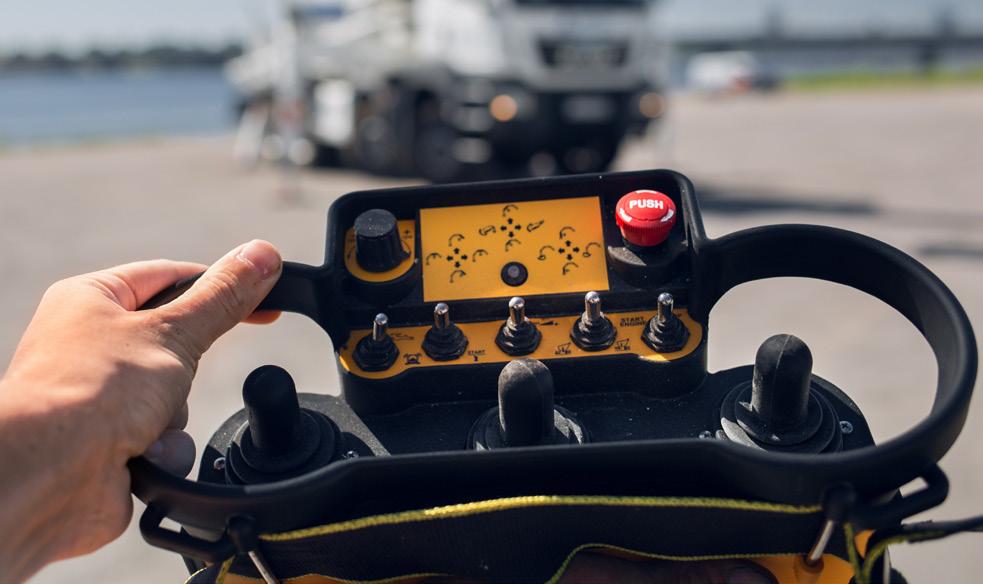
Advancements are bringing improved safety and efficiency to work truck operations.John Field is safety manager for Iowa Mold Tooling. Control systems can be easily adjusted from their default settings allowing work trucks, which are designed to take on many different applications, the ability to operate in different jobsite environments.
From the ability to remotely customize cab settings and control attachments to improved diagnostic capabilities and troubleshooting, the benefits of control systems are revolutionizing the construction industry
The LINKTower portable, linkable, zeroemission LED light tower includes 235-W LED fixtures for long-lasting and efficient illumination.
• Impact-resistant LED light fixtures provide 39% more lumen output and have 32% more coverage
• Powered supplied by a standard 120-V outlet, providing silent, emission-free operation
• Ergonomic folding handles and an added caster wheel allow for one-person maneuverability
• Smaller size fits through a standard door opening and a single person can set it up
• Can be used individually or as many as five units can be linked to illuminate large areas
Lind Equipment says its Beacon LED Lind Equipment’s LE980LEDV-T4 light Tower delivers as much light as a traditional light head with four 1,000-W metal-halide lights but in a completely unexpected package. The Beacon LED Tower uses direct-drive, high-efficiency LED lights and runs whisper-quiet on user-supplied generators or when attached to an external power source.
Compact and weighing just over 300 lbs., the Beacon LED Tower is manportable. Two can be transported in a standard pickup-truck bed. Although Beacon towers don’t come with their own power source, they can have a supplemental fuel tank built in with the capacity to run the tower using a 2,000-W generator for up to 45 hours between refueling. With acquisition costs at half that of traditional light towers, operating costs can be as low as $ 0.10 per hour. Both models are available with two or four light heads.
• Lind LED heads match Lind’s light-level tests show the Beacon LED Tower putting more light onto the work area than traditional metal halide light towers at median light output metal-halide output at 80% less power
• Lind lights warrantied for 3 years, rated for 50,000 hours
• Two towers can run on a 15-A circuit
The WAL-TP-2X50E-1224 tripod mounted LED light for work areas comes with two LEDP10W-50E LED spotlights that each produce 4,300 lumens of light while drawing 4.17 amps from a 12-V electrical system. This portable LED work light features five 10-watt LEDs that each produce 860 lumens that are paired with high purity optics to produce a 20-degree spot beam that is 525 feet long by 75 feet wide. The light features LED light bars that are waterproof up to 3 m and sealed to prevent dust and dirt from getting inside. The LEDs on this unit can operate on voltages ranging from 9 V to 46 VDC without the need for modifications. This LED light can withstand rapid temperature changes of -40˚C to 85˚C and features LEDs that offer 50,000 hours of lamp life.
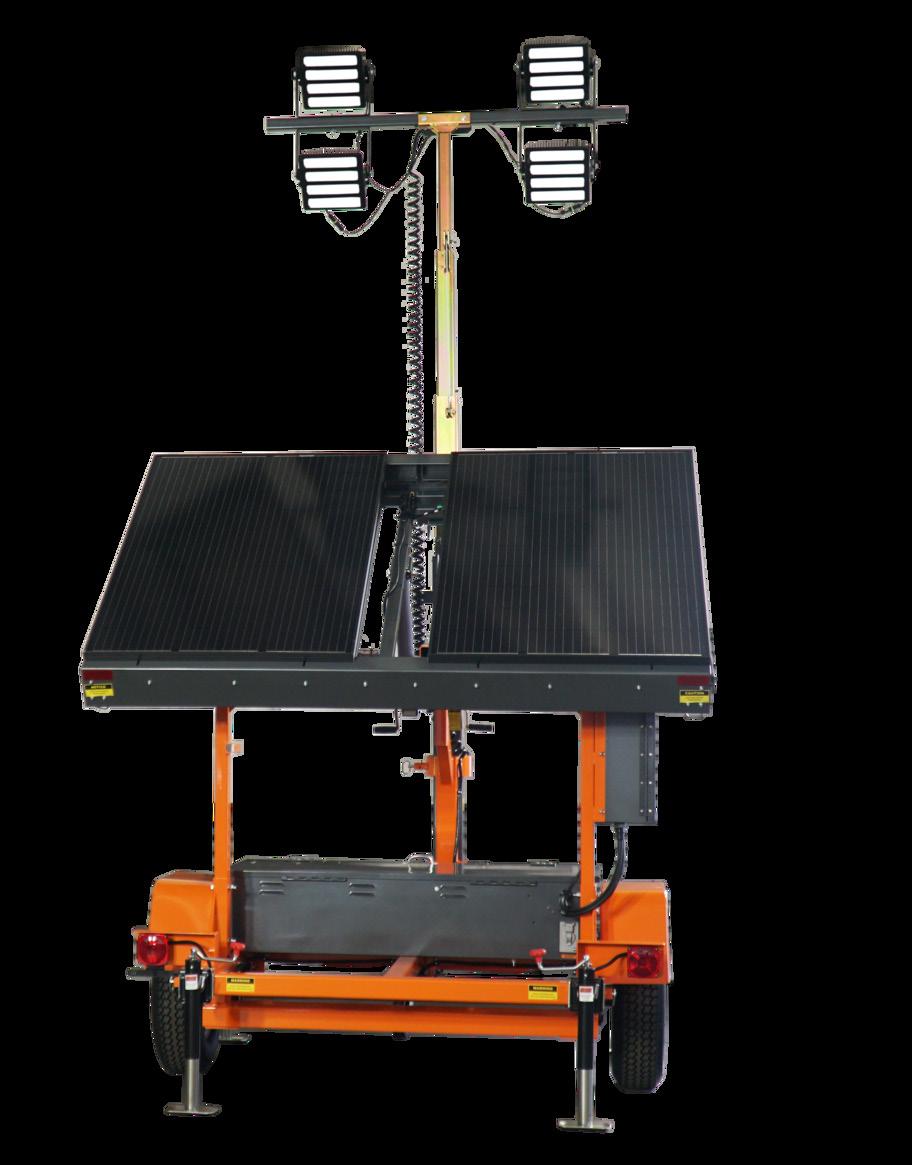
This tower is designed to meet the rigors of heavy-use areas such as construction, mining, utility and security. Its silent nature provides quiet operation. The LTS mast is built extra heavy to provide a solid foundation for almost any use. On top of the mast are four heavyduty LED light fixtures with ultra-high intensity, state-of-the-art LED’s with remarkable brightness. LED light fixtures boast brightness levels of 40 W, 85 W, and 160 W.
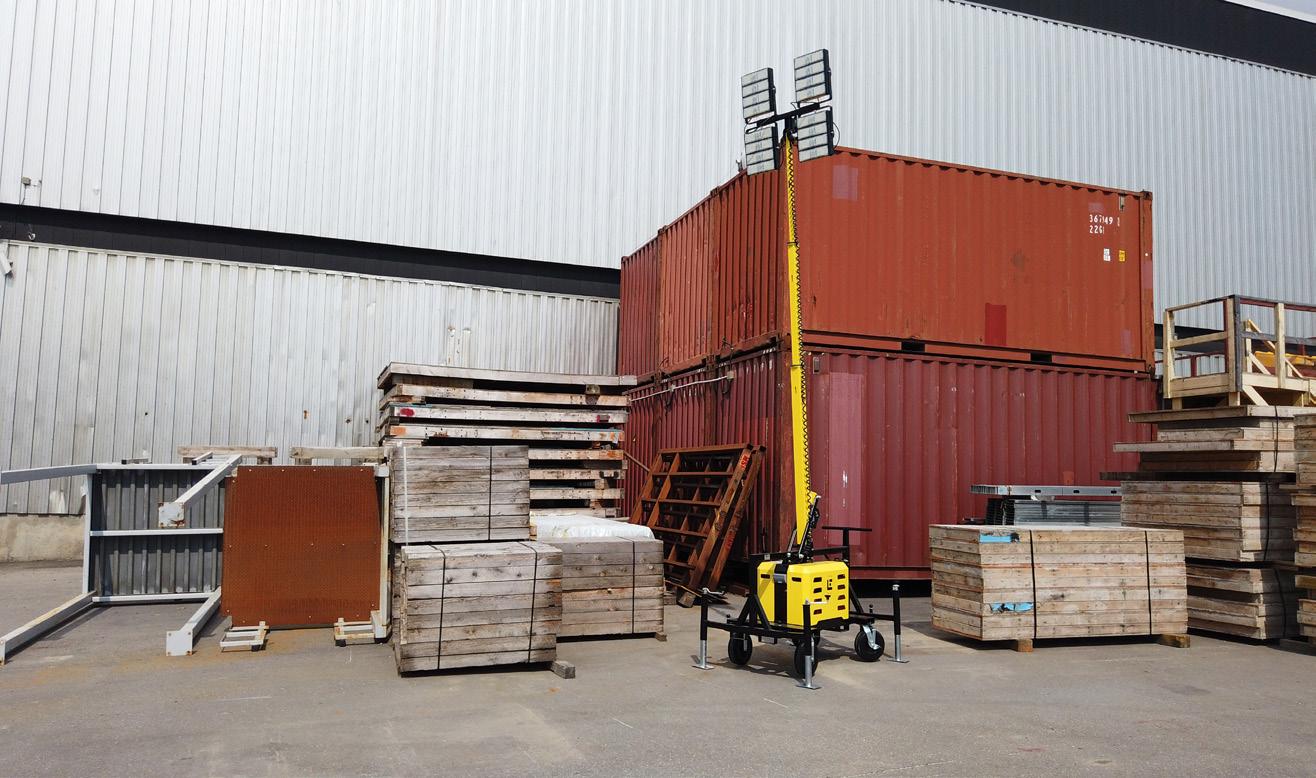
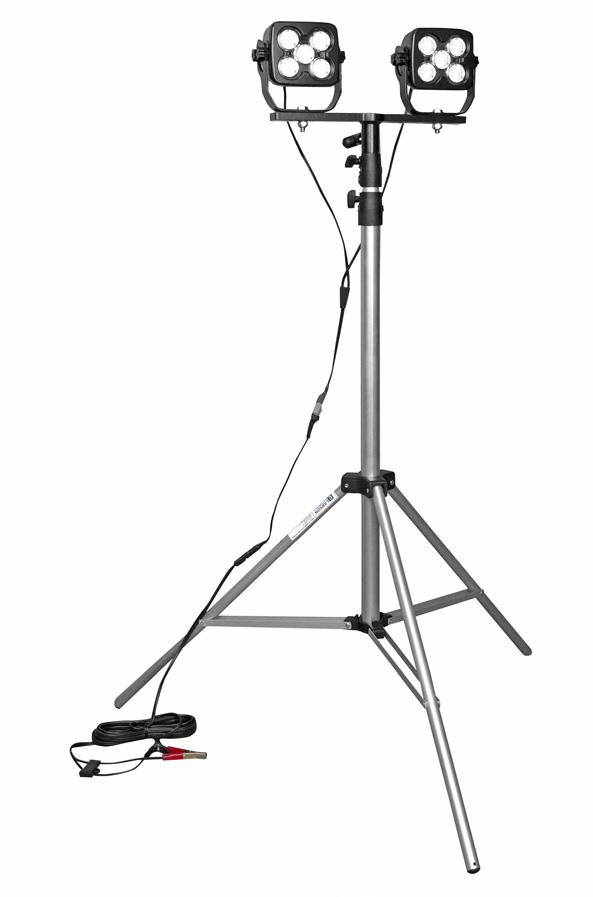
The Night-Lite GR-Series light tower has an air-cooled Yanmar diesel engine that provides lightweight, low-maintenance power and can handle temperatures of -6°F to 104°F.

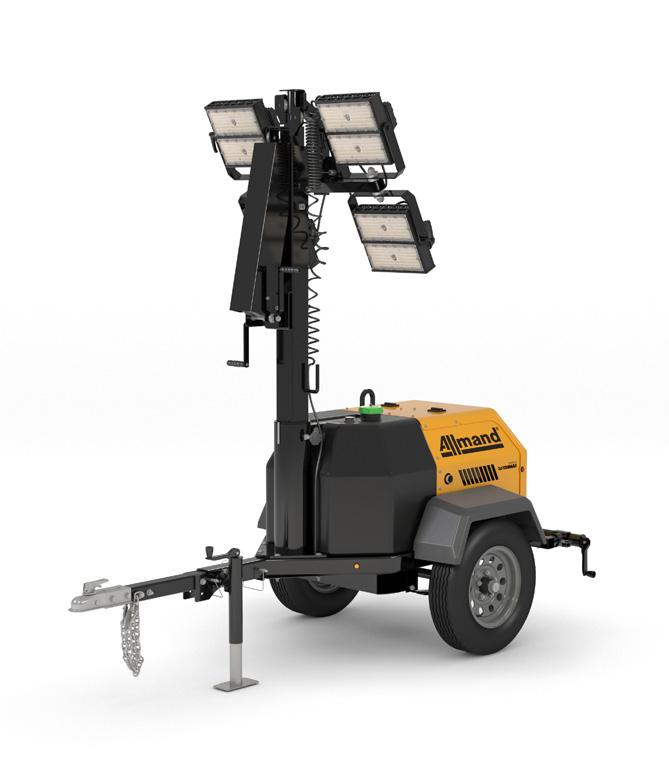
• Four fuel-efficient LED fixtures with 195,592 total lumens provide a 300-hour run time
• 40-gal. fuel tank
• 20 units can be shipped on a 48-ft. truck

• Simpler, lighter, lower cost GR-Series Chain model designed to be easy to deploy and maneuver, works with any 15-amp or 20-amp power source and features daisychain capabilities
The Basecamp green-certified heater, light tower and generator delivers efficiency as a flameless heater plus provides a 360-degree LED lighting package and 27 kW of available power.
• SmartTalk IoT technology monitors and controls the heater 24/7 and alerts via SMS or email before there’s a problem
• Light package produces 192,000 lumens 5K color
• Minimum run time of 48 hours with 27 kW of continuous power
• Kubota 2.4-liter, electronic Tier 4 Final engine
• 119-gal. fuel tank capacity
Fit-Finder
Ignite Attachments offers Fit-Finder for construction businesses looking to compare attachment products for their work vehicles. The Fit-Finder tool compares the specs of the carrier and the attachment to determine compatibility. The interface of the Fit-Finder delivers a simple experience and eliminates the need for holds or callbacks with the entire process accessible from its mobile-friendly site.


Ritelite Systems’ new quad pod
K65 mobile lighting towers gathers the maximum light emitted from the LEDs (measured in lumens) and enables users to optimize the light projected onto the work site (measured in lux) to suit their specific application. Specially designed optics enable the LED modules to be aligned almost parallel to the ground instead of pointing directly into the worker’s line of sight. This helps prevent accidents on the construction site due to distraction from light glare. The beam control LED light heads are driven by remote and dimmable LED drivers mounted at the base of the light mast. The Ritelite beam control system, delivers the following output levels: 180-degree directional illumination = 20 lux average over 6,868 m.


B2W Software added new alerts and notifications capabilities in the current release of its B2W Platform. The new features let contractors communicate automatically and in real time across the office, field and shop to support resource scheduling, field performance tracking and equipment maintenance workflows. More than two dozen actions taken in the B2W Schedule, B2W Track and B2W Maintain applications can now trigger messages delivered to selected recipients by text message or email. These actions range from creation of resource assignments and maintenance requests to submission, approval or rejection of field logs and mechanic timecards.

Trimble announced the launch of the X9 3D laser scanning system, a new reality capture solution for surveying, construction and engineering professionals. The X9 is built on Trimble’s laser scanning technologies, engineered for performance in various environments using Trimble X-Drive technology for automatic instrument calibration, survey-grade self-leveling and laser pointer for georeferencing.
A new center unit design supports signal transmission for scan quality. With reality capture capabilities, the X9 broadens potential applications for customers in surveying, building construction, oil and gas, rail, forensics, monitoring, tunneling, mining and others.
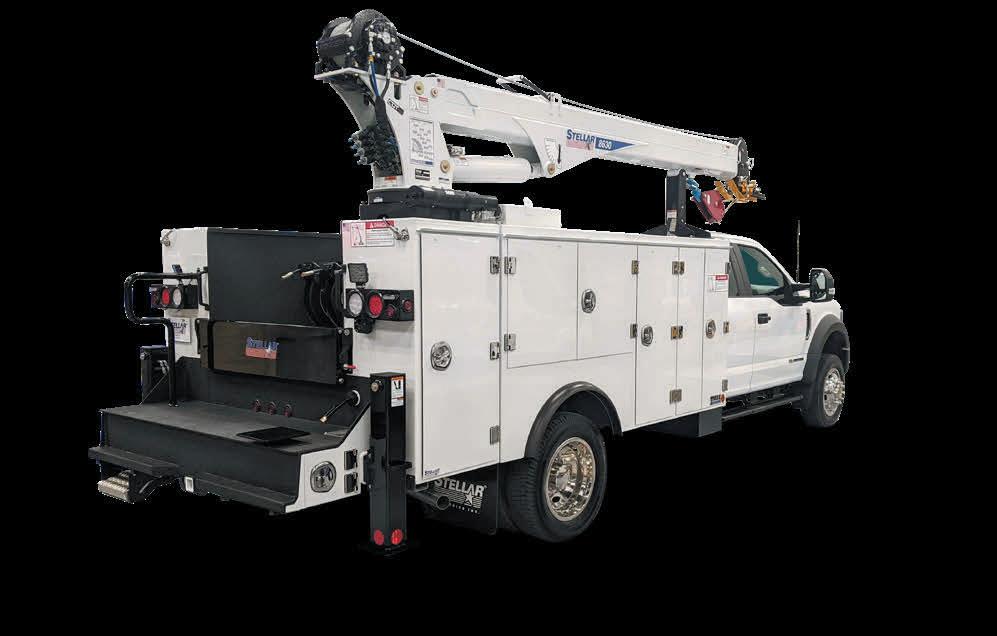

Heavy construction companies can use the HCSS Dashcams on their fleet vehicles to not only protect drivers but to avoid accidents. HCSS Dashcams integrate with the HCSS Telematics system. The HCSS ADPlus Fleet Dashcam is a plug-n-play dash camera with a built-in Al processor to detect driving events like forward collision and improper driver behavior, such as using mobile phone usage and distracted driving. HCSS Dashcams will alert the driver in real-time of potentially unsafe behaviors and upload events to HCSS Telematics to be reviewed by a fleet manager.

ToolWatch EHS is an environmental health and safety product offering that helps general and specialty contractors manage their safety programs. The addition of EHS expands the ToolWatch construction operations platform to integrate safety and compliance with other jobsite workflows and data. ToolWatch EHS offers a suite of safety management tools, enabling construction organizations to manage safety and compliance on a single platform. These capabilities include inspections, compliance reporting, training, observations, incidents, job safety analyses, custom safety forms and a dashboard for administration, data analysis and reporting.
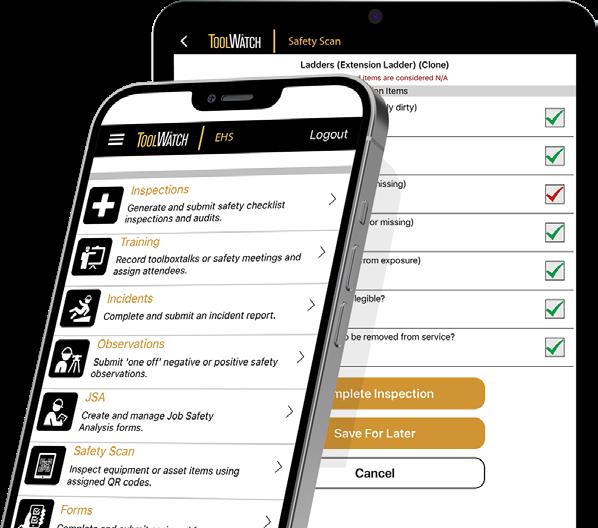
With a stronger-than-ever lineup of equipment and solutions that power productivity, our dedicated employee-owners are proud to engineer and build work trucks, trailers and accessories that live up to our name — helping you stay stellar at your job, too.
The Command console is a lightweight, portable console supported by a shoulder harness. Offering line-of-sight machine control from up to 437 yards away, it is suited for temporary or emergency remote operation with no on-site communications infrastructure required.
Longtime operators of off-road construction equipment may be extremely facile with travel sticks and pedals or levers for blades, booms and end effectors. But an expert operator in every cab is already hard to achieve, and demographic patterns and volume of work projected suggest it will get even harder.
Established and emerging machine control technologies can ameliorate this problem by:
˜ Enabling one operator to supervise and manage one or more machines remotely
˜ Lowering the barrier to filling positions with more intuitive controls
˜ Lowering the barrier to filling operator positions with automated operation
Technologies that enable an operator to control an excavator, wheel loader or other piece of equipment remotely have been on the market since Cat first began exploring remote operation in 2015, leading to the launch of Cat Command and regular expansions to more and more of the Cat product line from line-of-sight control Cat 988 wheel loaders in 2017 to loading, dozing and excavating operations in 2020 and excavating in 2021.
“One of the highlights is we have three different Command stations here, and that is our remote control offering where we are running seven different pieces of equipment in both our DNCs at Tenaha Hills, Arizona, and at Clayton, North Carolina,” Caterpillar Technology Marketing Manager Barry Littlejohn said from the company’s 1,500-square-foot technology hub at CONEXPO-CON/AGG 2023 (CONEXPO).
These technologies are supported and enabled by safety features like radar and camera systems in Cat Detect, ensuring that remote operation does not increase risk. Cat Command is sold in a package that includes:
˜ Line-of-sight remote control and can also be used in non-line-ofsight remote settings
˜ Dealer-installed field kits to make a machine Command-ready
˜ Multiple cameras for non-line-ofsite operation and stream on-site video feeds
˜ A microphone, cameras, indicator lights, a wireless receiver and antenna for mounting atop the cab
˜ Advanced features including Grade Assist, Swing Assist and E-Fence
While Cat Command and other, emerging remote operation technologies are coming to market first in mining and repetitive use cases, as the technology becomes more capable of sensing and responding to objects in

Off-road equipment technology is evolving to enable fewer operators with less skill to do more either on site or from a remote, centralized location while automating with a higher degree of accuracy.
the environment, they should become more and more applicable to busy construction sites.
The potential market for remote construction equipment operation is large enough that emerging vendors are also angling for a piece of the market. Founded in 2019, Palo Alto-based Teleo, for instance, raised $12 million in a Series B round in June 2022, in addition to a seed round in March 2020. The company employes 20, the majority of which are in engineering, according to co-founder and CEO Vinay Shet. At CONEXPO, the company announced new customer nameplates including John Aarts Group, Teichert and Tomahawk Construction. Perhaps more importantly for intermediate term success, they also announced dealer partners in the U.S., Canada and Europe.

“What we offer our customer is all the layers—retrofitting for automation, the control station, network connectivity on site, AI algorithms and the cloud software to collect productivity data,” Shet said.
“We have a system around safety that means if connectivity for the machine is ever broken, we have a way to stop it if something in the way that is not supposed to be there.”
Safety is baked into Teleo remote operation solutions in a number of
ways including unimpeded rear visibility, with Shet crediting cameras under the bucket, for instance, for unimpeded views of the work area for operators using wheel loaders and skid steers.
“Full autonomy is many years away,” Shet said. “What we deliver is supervised autonomy — we want to bring all the sensory queues from the machine back to the operator.”
While some remote operation solutions are geared more for line-of-sight control of the equipment, with an operator standing nearby, solutions like Cat Command and Teleo require a commercial internet connection with low enough latency to offer real-time control.
“Connectivity on the job site is crucial,” Shet said. “We have our own networking solution — it is critical for the machine that we deploy a mesh network on site.”
While Cat Command and emerging rivals aim to enable remote operation, other technologies aim to enable operation not just outside the cab, but through means that are more intuitive for an untrained operator. Work taking place at SRI International, a Menlo Park, California, nonprofit research
institute aims to enable operation of an excavator by hand signals a joystick or even autonomously.
“The idea is to have a system that enables you to operate the excavator while not physically on the excavator,” SRI International Senior Robotics Engineer Reuben Brewer said. “The operator can work on-site or dial in from a different site. This is important because an excavator is often sitting idle during construction, and during that time, you can do something useful. Sitting in a warehouse or office, while waiting for the crews on site to be ready for the next digging task, I can dial into different jobsite.”
While much of this capability may seem duplicative of Cat Command, Teleo and other emerging vendors, there is more to SRI’s research than remote operation.
“We are looking at the system as a more complete package,” Brewer said. “Remote control of an excavator is not new — but we are the only system that includes active human detection. The excavator can stop, pause or slow if human is detected. We also focus on the immersive virtual reality environment we place the human operator in.”
More sensory inputs, according to Brewer, have proved essential to enabling effective remote operation.
“The virtual reality component is
essential,” Brewer said. “When we first started, had dumpsters we were digging rock from, taking rock from dumpster A and putting it in dumpster B. Without the headset, we were missing the dumpster entirely 50 percent of the time. From 50 feet away, we did not have depth perception to do it properly. You put on the headset and suddenly it is a 100 percent success rate.”
Ensuring a remote operator has not only depth perception but the ability to see the entire environment is crucial for safe remote operation.
“We give you input to all of your senses,” Brewer said. “Because you cannot turn your head to see, we do additional sensing including 360-degree camera coverage. Rather than rely on a video feed that may not be useful if the human operator is distracted, we use machine learning to do detection. This is important for urban environments — if anyone gets near, we shut everything down. This may not work well on a busy urban sidewalk, but you can set zones behind the excavator so it can just not go in reverse if there is an obstruction.”
Once the operator is out of the cab, they can control the excavator either through a joystick control box or by using simple hand gestures, using the hand like a scoop to indicate the digging motion.
“The ability to follow the hand is
something that helps get new operators up to speed addresses the labor shortage,” Brewer said. “When they get in the machine, operating the bucket with the controls is a left-right pattern and the brain cannot remember that because the boom goes front to back. We figured out a rolling pattern for the boom and the bucket.
“Working with a group of new operators with traditional controls, most could not scoop gravel off the ground. Five minutes in with our system and they were scooping and taking material from point A to point B. They were digging nicer-looking holes and not missing piles of dirt. If they were experienced operators but had not dug for a few years, the hand gestures were still more intuitive.”
Regardless of whether machine control technologies consist of remote operation tools, grade control driven by GNSS signal, or reality capture tech that enables a machine to respond to its surroundings, fleet owners have two choices—they can rely on technology provided directly from their original equipment manufacturer (OEM) or solutions delivered after the sale by third parties.
The 2023 State of the Industry
Construction Technology Report lays out adoption curves for technology to automate operation of construction equipment is coming both from the OEM as a stock feature or as an aftermarket option sold by companies like Trimble, Leica, Unicontrol, Teleo or others. OEM machine control was the approach used most by study respondents, with 27% using it already, 5% budgeting for OEM-based machine control and 11% planning for it at some point in the future. Only 15% of respondents, meanwhile were using aftermarket machine control, 5% had it in their technology budgets and 12% were planning to roll it out in the future.
One reason contractors may opt for OEM machine control tools is the prospect of damaging the solution’s sensors will be diminished by thoughtful installation. Convenience during the purchasing cycle and potentially higher market value for OEM-equipped machines may also be factors. For these and other reasons, Caterpillar has been gradually making machine control features like grade control standard on some equipment classes, including hydraulic excavators. Case meanwhile offers a universal machine control option that makes each machine factory-compatible with all major suppliers of machine control technology, including Topcon, Trimble
and Case precision partner Leica Geosystems.
While factory-integrated machine control options are more popular than aftermarket according to the data, emerging products from vendors like Unicontrol, Sodex, Teleo, Stonex Machine Control, Moog Construction, Kiwitron, Built Robotics and others may increase the percentage of contractors and fleet owners retrofitting for machine control. Alternatively, as more OEM equipment comes with standard machine control capabilities, the balance could tilt further towards OEM options or stay the same. This bears watching as the market figures out if the simplicity of factory machine control is preferable to aftermarket options.
One final trend affecting machine control for construction is the proliferation of technology options to prepare data for consumption by machine control solutions, as well as those that harvest information for progress reporting, other reporting and as-builts.
Trimble Earthworks is probably the dominant solution for this application and relies on a USB stick and File
Flipper app to transfer files directly onto a machine in the field.
Other options for this and other machine control data tasks include InSite Elevation Pro from InSite Software, which has in recent years been completely reimagined in 2020 for ease of use and performance. New features continue to proliferate, including the addition in April of 2023 of RockAlert, which gives machine control systems data on the location of rocks, water and other strata.
Quantum Land Design meanwhile in April of 2023 launched Quantum Flight Pack, a utility that enables a contractor to use a GPS rover to collect ground control targets, launch an automated drone flight over the property and then process drone data and run volume calculations for takeoffs.
Read more at: https://eqtoday.co/gykin1
Aftermarket machine control could rise in popularity compared to OEM options as more technology vendors enter the market.

It really is decision time. Time to decide how you plan to grow your business, as well as its value. Decisions need to be made about technology, tax planning and cash flow results. For many of you, the decision will be whether you are up to making the necessary decisions knowing that those decisions will take time and
expertise to attain the results you are expecting.
If you are close to retirement, you may conclude that you do not have the time and money, nor the internal talent to manage a growth project that will keep you competitive and add to the value of your company. In that case, you need to adopt a program to clean up the operation to make it look good for potential buyers. I have seen way too many examples of contractors getting tired of the daily grind to the point that they just let the operation deteriorate, and they just walk away from the company, sell off their equipment and head south for the winter. I bet you have come across owners who have done this.
In either case, whether you decide to increase the value of your company via technology and productivity
improvements and buying other operations that fit your customer base, or just want to improve what you have to ready it for sale, you have to start by adopting a marketing plan to get the ball rolling in your favor.

This is not rocket science. Many options out there are geared toward small contractors. They provide leads for new business as well as keep you in touch with current customers. For $300 to $400 per month you would be amazed at what you could do.
My son did this type of work with a system where he could see how many contacts were showing up on your doorstep, and he would give you a call if your sales were not moving up as a result. Do you know what he found out? He discovered (and already knew) that the calls and contacts were coming in, but the contractor was not
answering the phone nor following up on other types of digital inquiries. Imagine that!
He would then provide contractors who did not have time to manage their leads the name of someone who worked from home and could answer your phone for you.
You provide a little training so that they ask the right questions and get them to you for follow-up … and follow up with you if you don’t.
This example leads me to a couple points about business growth and company value.
Point 1: Do not try to manage this process on your own. Outsource all you can so that you only get involved when making decisions and providing follow-up. I am not suggesting that you hire a bunch of heavy hitters at the outset of this process, only a person or
Using technology for your business improves the bottom line and decreases your time using pen and paper.
two who can assist with documenting and implementing the game plan.
On a side note, I know a gentleman who purchased a small contracting company from a buyer in walk-away mode. Guess what? He asked the seller to hang around for a year, implemented a marketing plan and doubled the volume in Year One. This brings me to Point 2.
Point 2: Buyers purchase cash flow and asset value. So, you must have a document explaining what you do, how you do it and how much you make doing it. It also helps you compare your results to industry metrics, which will provide insight as to what may be possible with upgrades in systems and marketing.
It would be nice to have internal folks who could provide their data, but that means someone must instruct them as to what is required and when. This process may also require a coach with knowledge of what buyers want to see and how your operation compares to industry standards.
In terms of asset values, you may need to obtain an equipment valuation to compare market value versus book value. If the market value is higher than book, the value just went up.
What brought me to this topic this month was a McKinsey article comparing the 2023 construction industry to 1930 when the Empire State Building was constructed. According to the article, things have not changed much. On the other hand, the industry is doing all it can to improve productivity, which means producing more with less. And if you think this will lead me to a statement about technology … you are correct.
Three events started my thinking this way.
• I sat through an advanced Excel class.
• I listened to a YouTube program about how to manage your iPhone.
• I had a friend who sells complicated equipment who had Chat GPT draft a sales letter to some new prospects.
After these three events, reality set in that told me that these types of actions, used properly, can improve my productivity immediately.
If you do not have someone who can manage your data using Excel, you will regret it. Again, if you do not, then find a person who can work with them.
During the iPhone presentation, the speaker instructed or asked SIRI to do about 15 different tasks, and they were taken care of instantly.
The sales letter was also quickly obtained. He reviewed it, made a couple minor changes and let it fly.
Talk about productivity improvement. These tasks probably
took about 10% of the time to do the “old’ way.
Today’s comments are directed at contractors with 10 to 20 employees.
Are you ready to embrace technology?

Do you think you can improve productivity with these types of tools?
If you are not able or don’t believe you
have time to implement change, you may want to work on an exit plan so that you are prepared when the time is right.And please watch the YouTube program about using the iPhone. You will never use paper and pens again.

Read more at: https://eqtoday.co/decisiontime
With hands-on workshops and in-depth learning, you’ll discover new ways to get more value from the products you use.
While you’re at it, you’ll realize the network effect of connecting with the Trimble community, sharing knowledge and working together move your business forward.

If you feel like there are fewer workers to be found these days, rest assured, you are correct. A decrease in the rate of births,
declining since the 1970s, decreasing labor market participation, more job openings, a shortfall of immigrants and a surge of retirements, are creating a workforce problem that is hard to ignore.
Although we continue to experience the challenge, many of us still cling to the flawed idea that continuing to do what we’ve always done will somehow, some way, finally yield positive results. So, for those of you who need a bit more convincing, let’s take a look at the data, create some urgency around why you need to make some changes, and then talk about potential new and effective approaches to recruiting.


We need over 2 million more people in the labor force to recover to the 63.4% labor force participation rate we had in February of 2020, just prior to the beginning of the COVID-19 pandemic. We also need 175 million more people in the labor force to just bring us back to the number of people who were working at that time.
The labor force participation rate is only a measure of currently employed individuals and people actively seeking work (unemployed). If you’re sitting on the sidelines, as an estimated 40% of our total population is right now, and you’ve chosen not to work or have just given up looking for a job, you are no longer being
Just like we market differently to different audiences, we can no longer rely on just posting in the same locations in the same ways.
counted as unemployed. So, what are the most common reasons people are on the sidelines? The major ones are as follows: retirement, school, family caretaking and being unable to work.
The job market is currently booming, with millions more jobs available than there were prior to COVID-19. As I write this, there are just over 10 million job openings (an increase of 3 million jobs from February of 2020). This chart shows the ever-growing number of jobs available across all industry sectors.
The takeaways here should be evident. Your opening is not only competing with others in your
Being intentional about posting positions to different talent pools is key to refreshing your old recruitment routine.@Sam Edwards/KOTO - adobe.stock.com
Gain Access to a Three Part Series, Including:
• Part 1: Why Contractors Need to Get Serious about Offsite Construction
• Part 2: The Rise of Software for Offsite Construction



• Part 3: Offsight Builds Out ERP for Modular, Panelization and Volumetric Construction
To Read the Full Report, Visit: IRONPROS.COM

industry, but also with all the interests, skills and talents one person has that overlap with every open position. There are many more opportunities to change career paths and just try something new. According to the U.S. Bureau of Labor Statistics, the average term workers stay with their respective job is four years. However, for those younger than 35, that average drops to 2.8 years.
Many companies are looking to immigration to help offset their labor challenges. It is a hedged bet, however, and one that may help only in the short run. Consider the fact that net international migration is decreasing.
Birth rates in many of countries we get immigrant workers from are slowing, and unemployment is low. The onset of COVID-19 and advancement of restrictive immigration policies resulted in a sudden drop in our immigration numbers.
At the beginning of 2022, we were running 2 million immigrants short of the trend taking place prior to 2019, the restaffing of immigration offices has allowed us to make up much of the lost ground. However, the past two years has shown the fragility of planning on immigration to close workforce gaps.
The other workforce pressure we find ourselves experiencing is the growing retirement rates. Quite simply, it is something many of us knew was coming. However, it is also something for which many of us have not adequately prepared.
The combined forces of fewer people, more jobs, uncertain immigration and a high level of retirements created a perfect environment for changing how we look at recruiting. After all, as we have learned, doing what we have always done is not even getting us what we use to get.
Let’s approach recruitment with two ideas in mind: who’s available and willing to work, and of that group, who’s not represented in our workforce. This can be easily done by segmenting the workforce into population pools and determining the availability of each of the population pools. If you recruit from the mainstream pools you always use, you recruit from the pool with maximum competition.
Here’s how these talent pools might be broken down along correlating unemployment rates:
˜ Mainstream adults
˜ Unemployed (3.7%)
˜ Underemployed* (4.5-7.1%)

˜ Unhappily employed
˜ Veterans (2.7%)
˜ Minorities (2.9% Hispanics / 5.9% Blacks)
˜ Women (3.3%)* This isn’t accurate, as many women who left the workforce in 2020 have not returned and are no longer counted in this figure.
˜ Second chance (30%+)
˜ Youth (8.2% /teenagers—24 years)
˜ Retired
˜ Unengaged on the sidelines— flexibility makes it easier to engage (Updated September 2022)
When reviewing the talent pools, a few things should be considered:
˜ The largest, most underused talent pool with the highest rate of unemployment is the secondchance or ex-offender talent pool. Many correctional facilities have skills training programs that fit manufacturing needs. Approximately 650,000 secondchance citizens return to their communities annually. The chance of being a repeat offender drops significantly a person has a livingwage job. If you have not engaged with this audience before, now is the time. The chances are good that you have neighboring businesses that are hiring from this talent pool. Ask around. These employees are some of the most loyal you can find.
˜ Manufacturing needs to draw from the minority talent pool. Let’s stop considering diversity optional and start finding creative ways to market to minority population pools. Think about where you’re placing your ads, what your wording implies about your company culture, and ways in which you can invite this talent pool in and make them feel welcome. Doing what you have always done has not accomplished this as an industry. Be intentional and start small if you’re overwhelmed by the prospect of making changes in this area.
˜ Veterans are a fantastic talent pool to connect with, as there are nearly a quarter million service members leaving their branches annually. About a third of veterans are looking to return home and a third are staying near their last base,
which leaves a third looking for their next location and opportunity. Invite them to join your team.
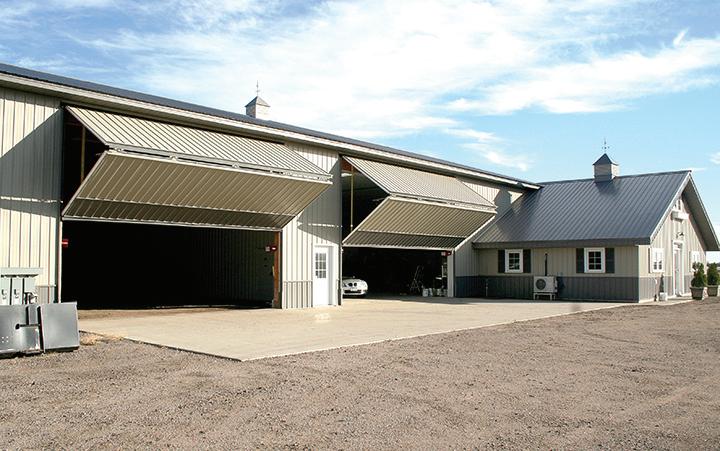
˜ Women have historically been missing from manufacturing. As an industry, we need to find more effective ways to invite half the population into our workforce conversation. And to me, there are two things to be aware of when recruiting this talent pool. First, be aware of your language. Run your posting through this site, which will help you understand if you are over-masculinizing your postings. Second, although the unemployment rate looks low for women, data suggests that 1.1 million women haven’t returned to the job market after leaving in 2020. Job flexibility is key when finding ways to attract this population. Being intentional about posting positions marketing to different talent pools is key to refreshing your old recruitment routine. Just like we market differently to different audiences, we can no longer rely on just posting in the same locations in the same ways.
Think about who’s missing from your workforce. Then ask yourself how you can build out your team, benefit from diversity of thought and invite other talent pools to connect with you by implementing some well-conceived strategies and tactics.
Julie Davis is the director of workforce development for the Association of Equipment Manufacturers (AEM).
Read more at: https://eqtoday.co/dp0roj
Trailer Weight: 8,380 lbs. • Overall Width:102", Length: 31'4" • Deck Length: 21’ Flat (model shown)



• 6’ Beavertail • Deck Height: 34" • Tires: Eight 215/75R17.5 (H) • Brakes: Air (Full ABS System) • Ramps: 72" Long x 22” Wide Range: 102" Max. 29" Min.
Lighting:100% Sealed Wiring harness and L.E.D. Lights


It’s all about doing more with less. So we did, with the widest range of machines equipped with grade management tech to suit your job needs today, and tomorrow. From 2D Laser Control to fully-integrated SmartGrade™, it allows any operator to grade with precision. Reducing passes, labor costs, and dreaded rework, to boost your bottom line.
